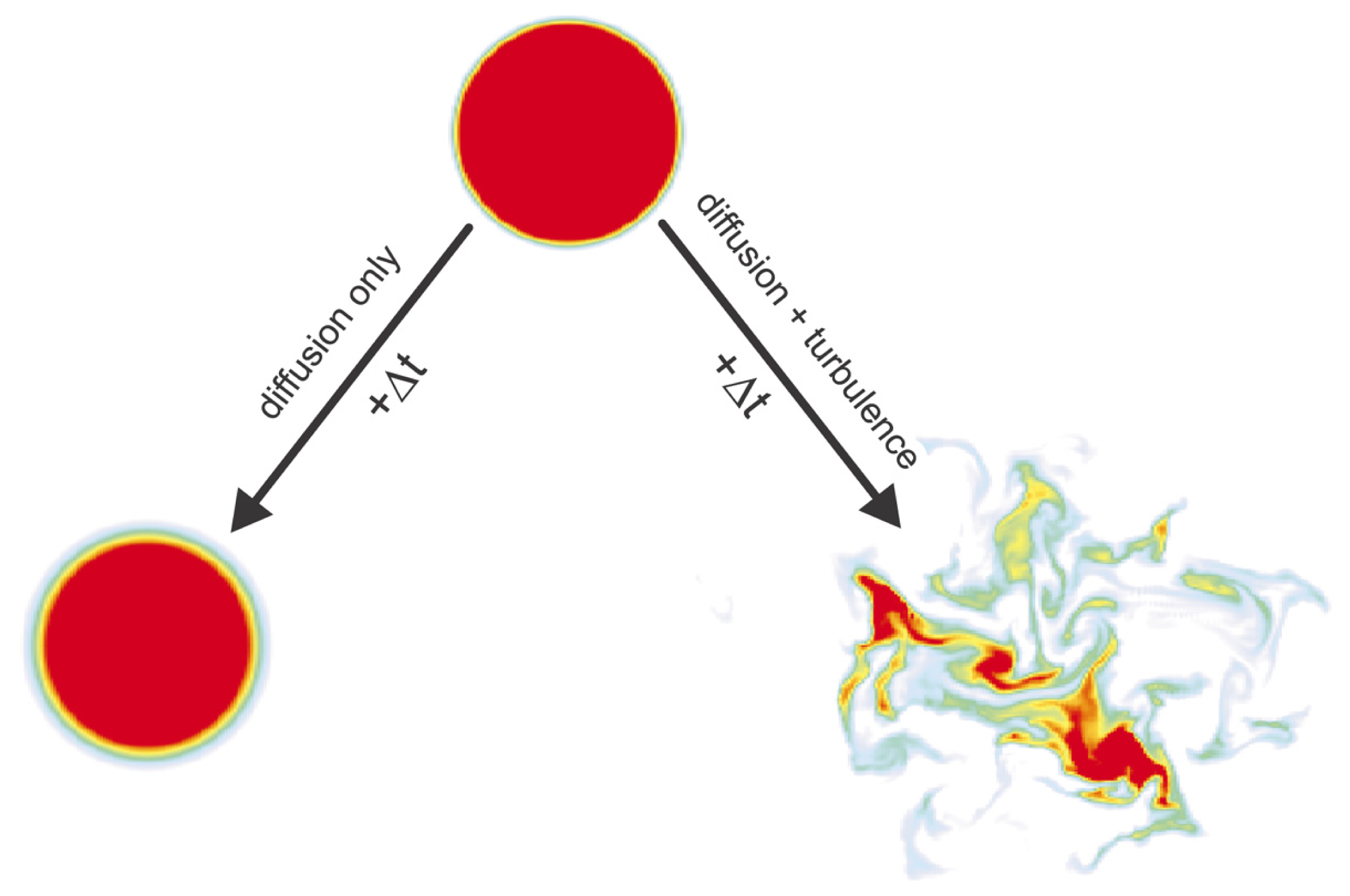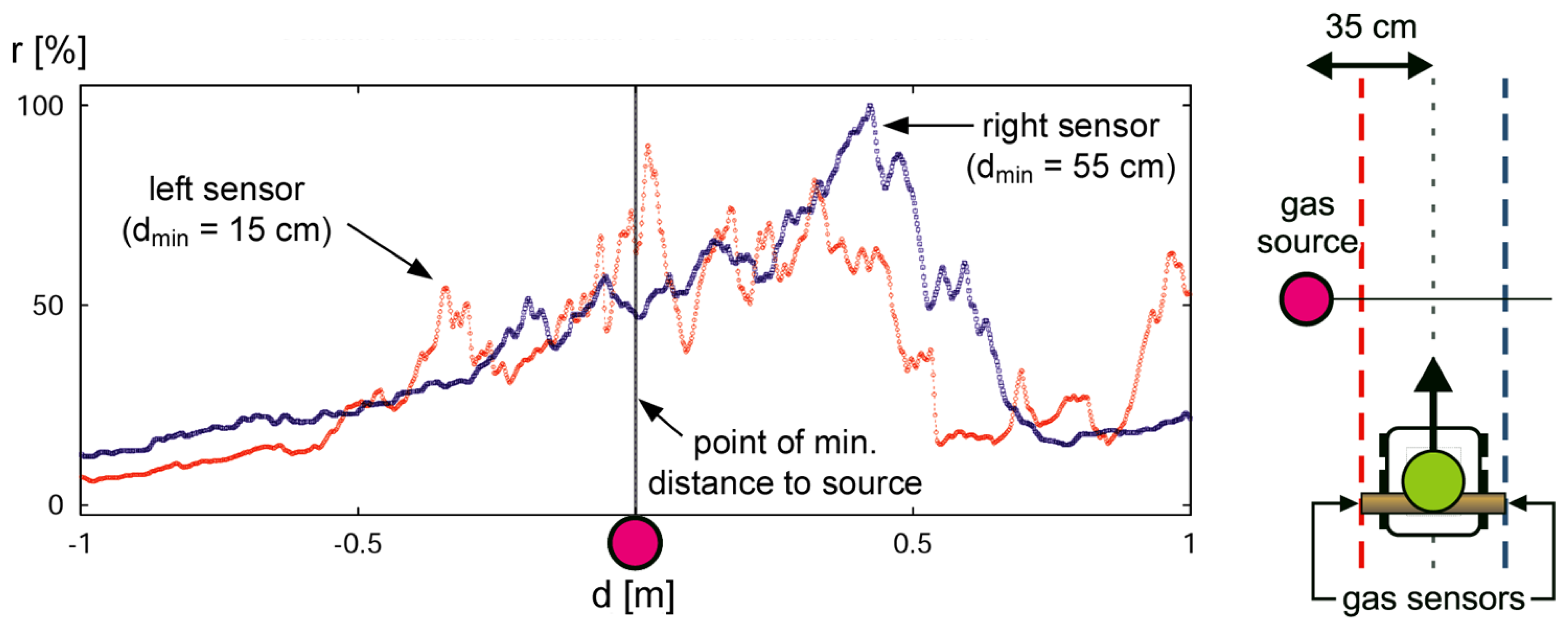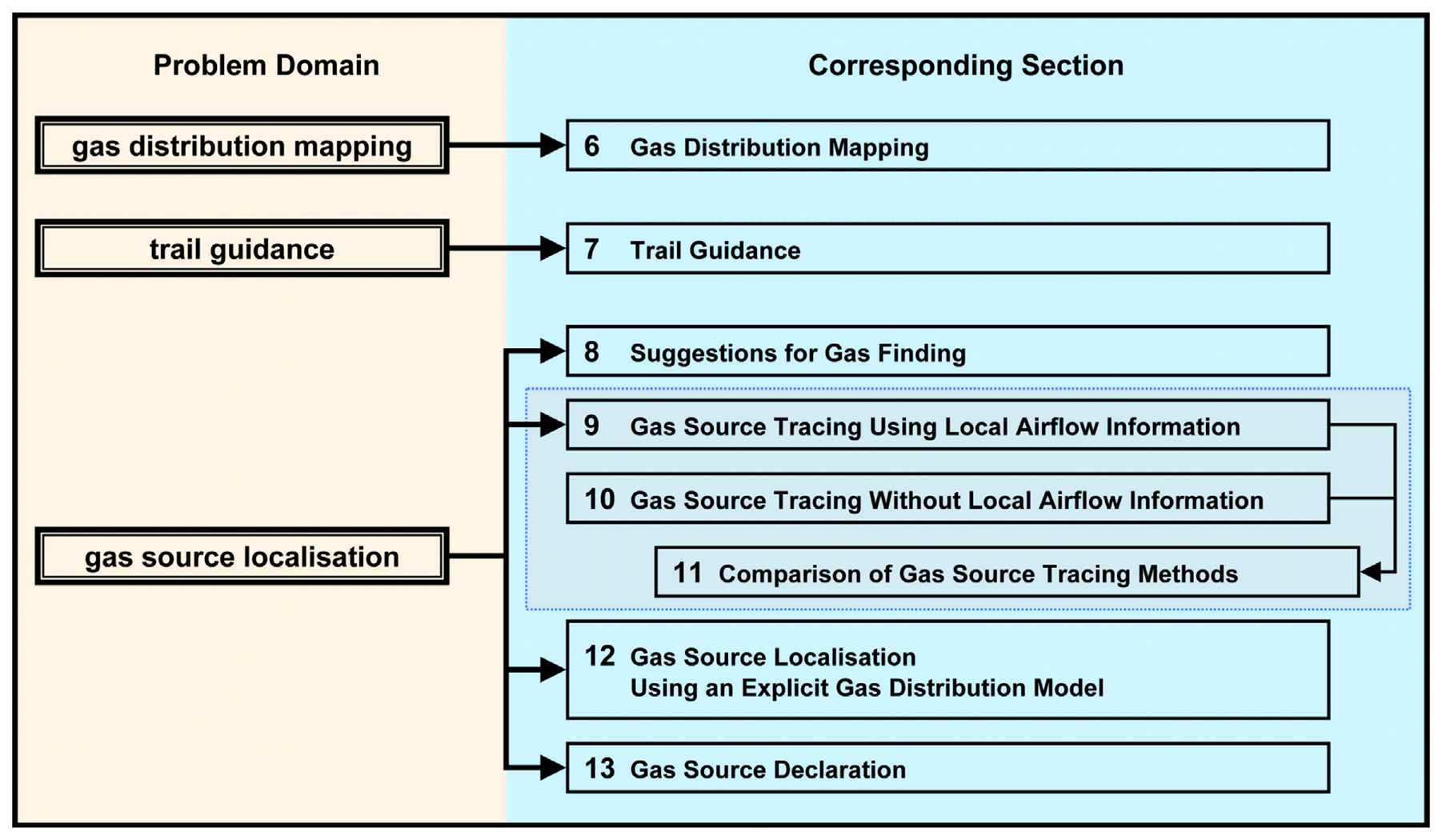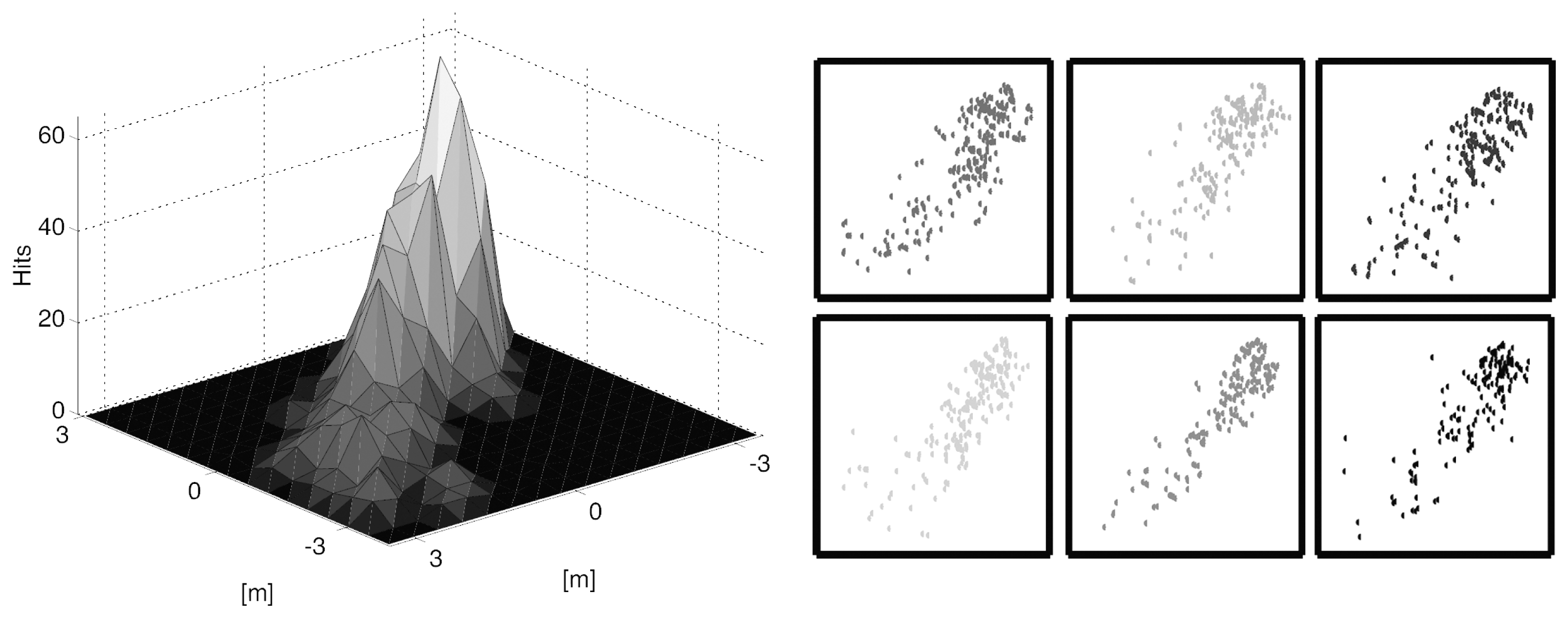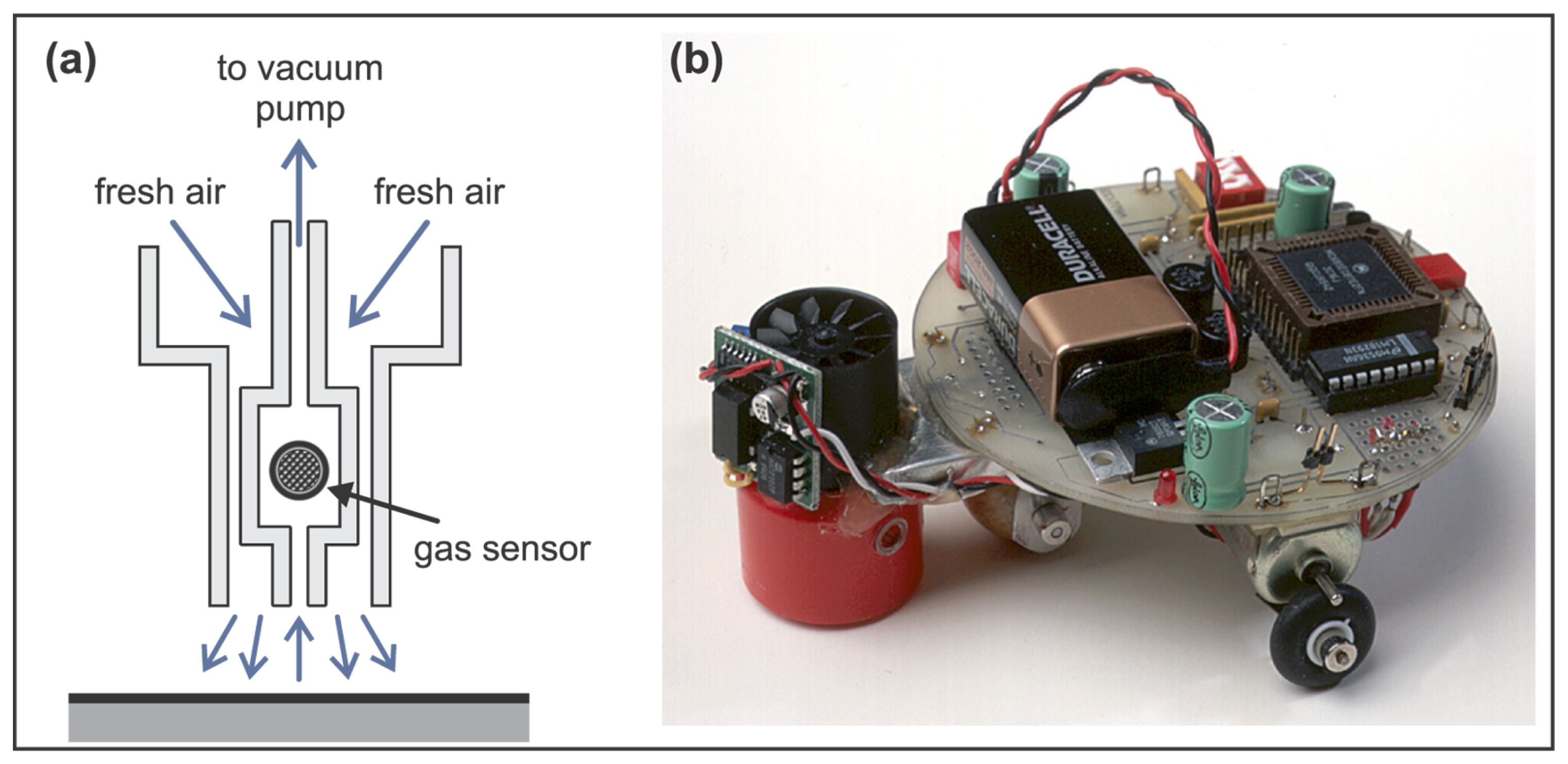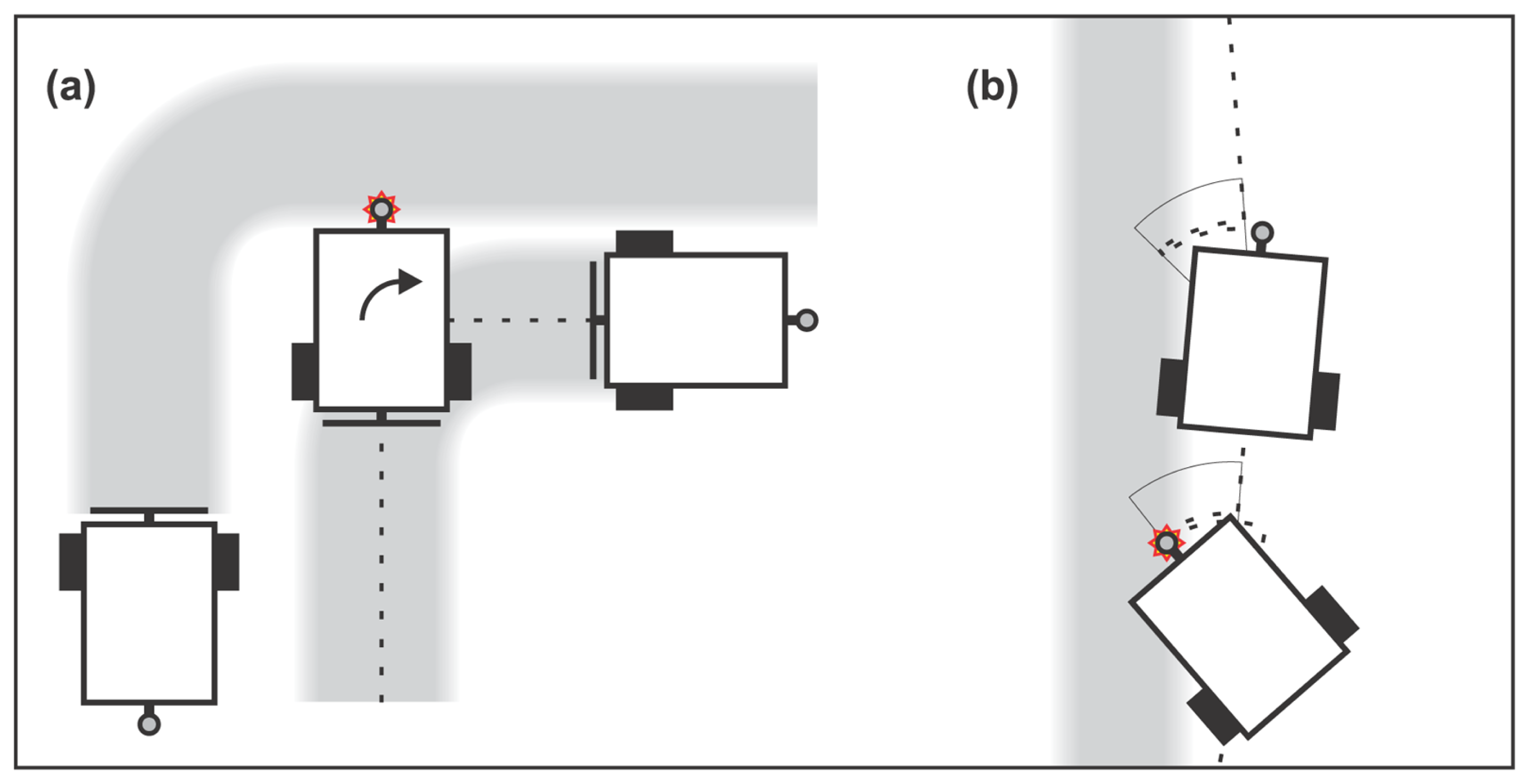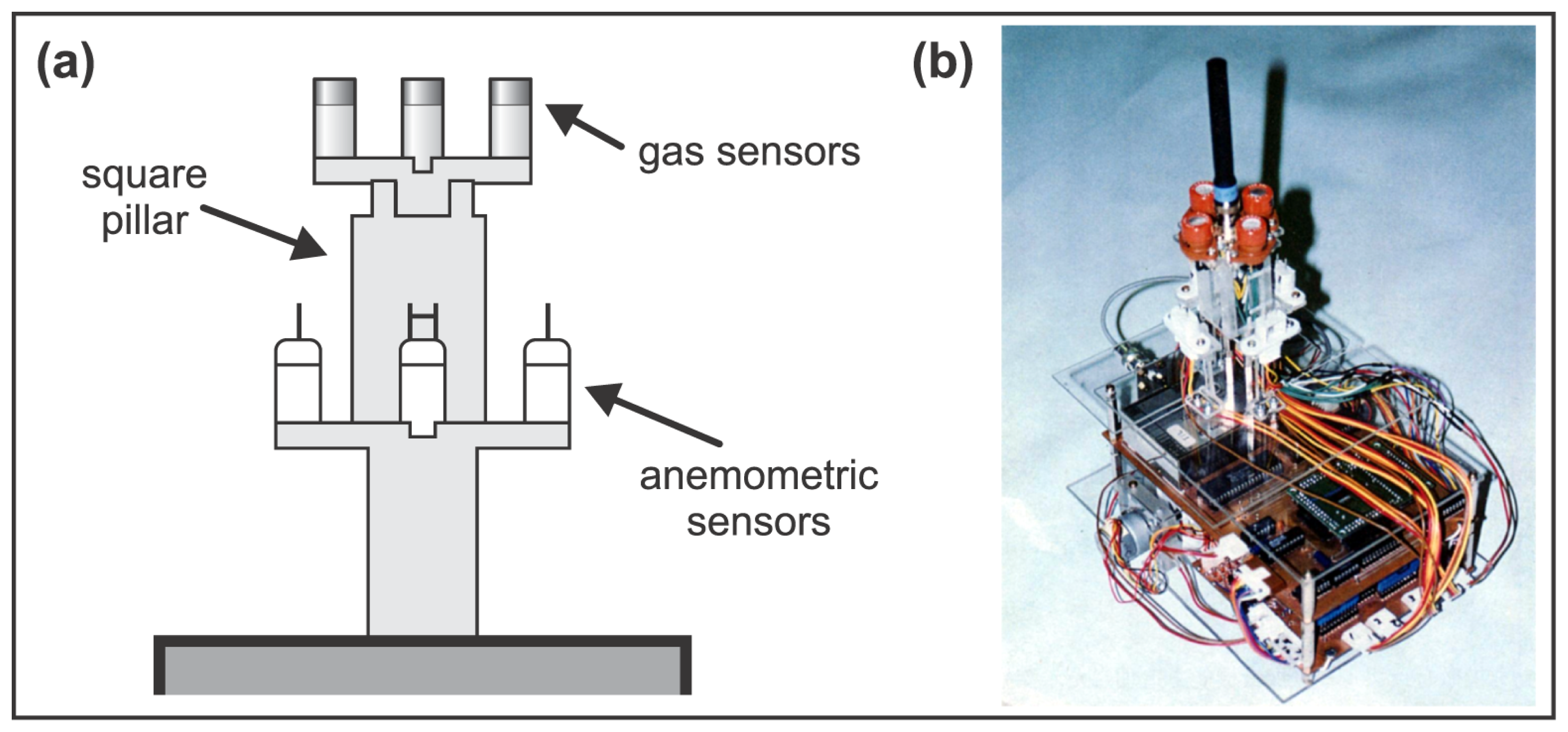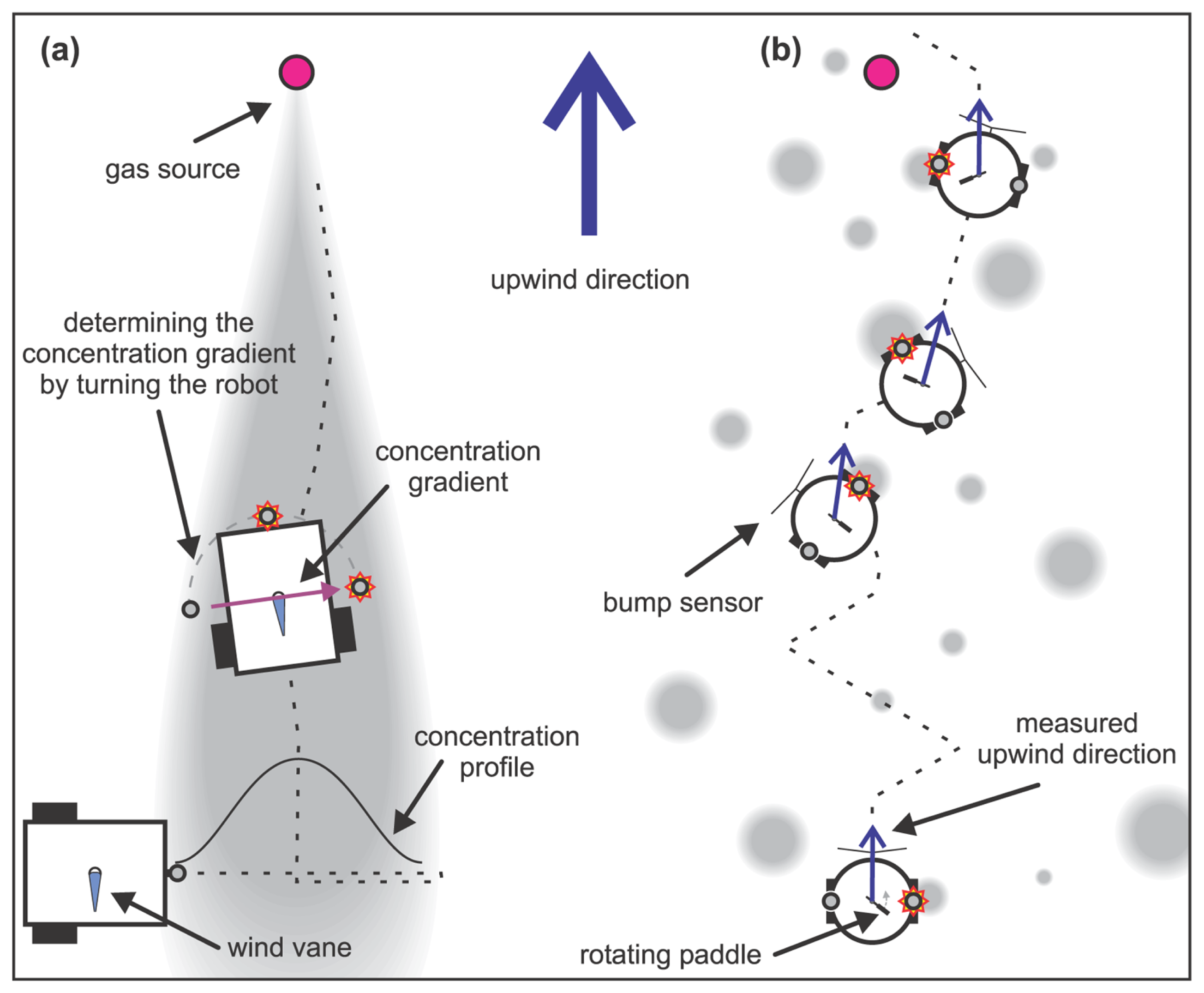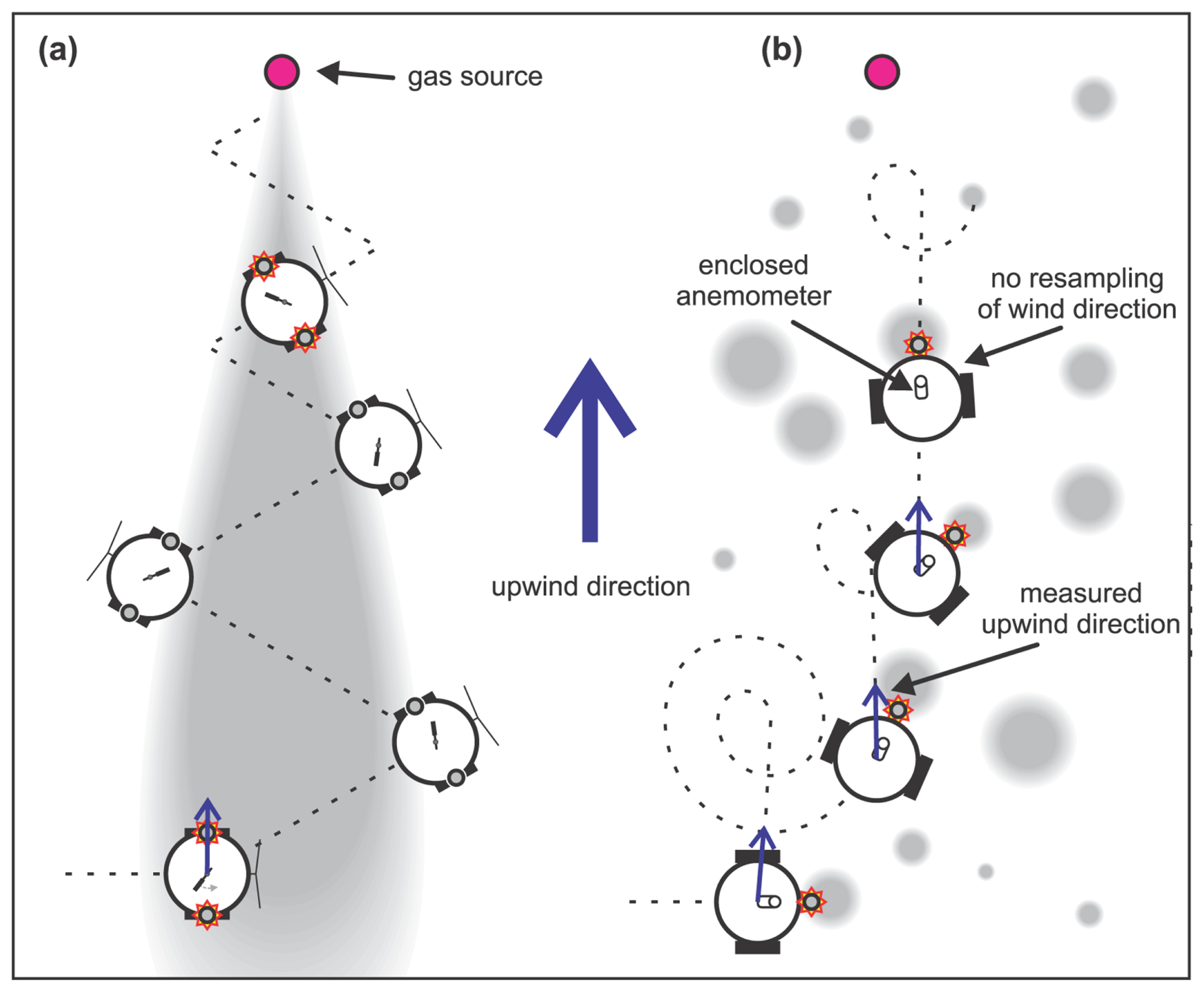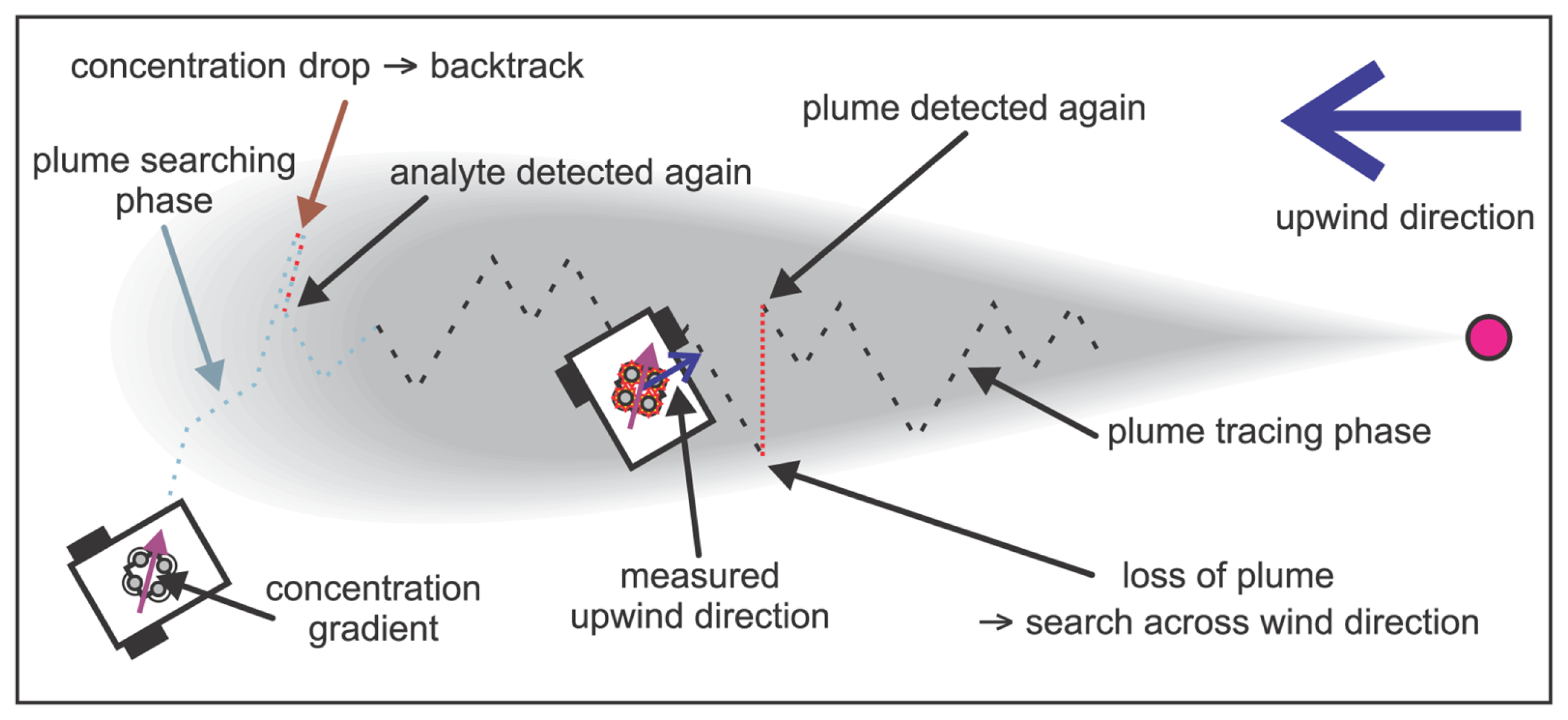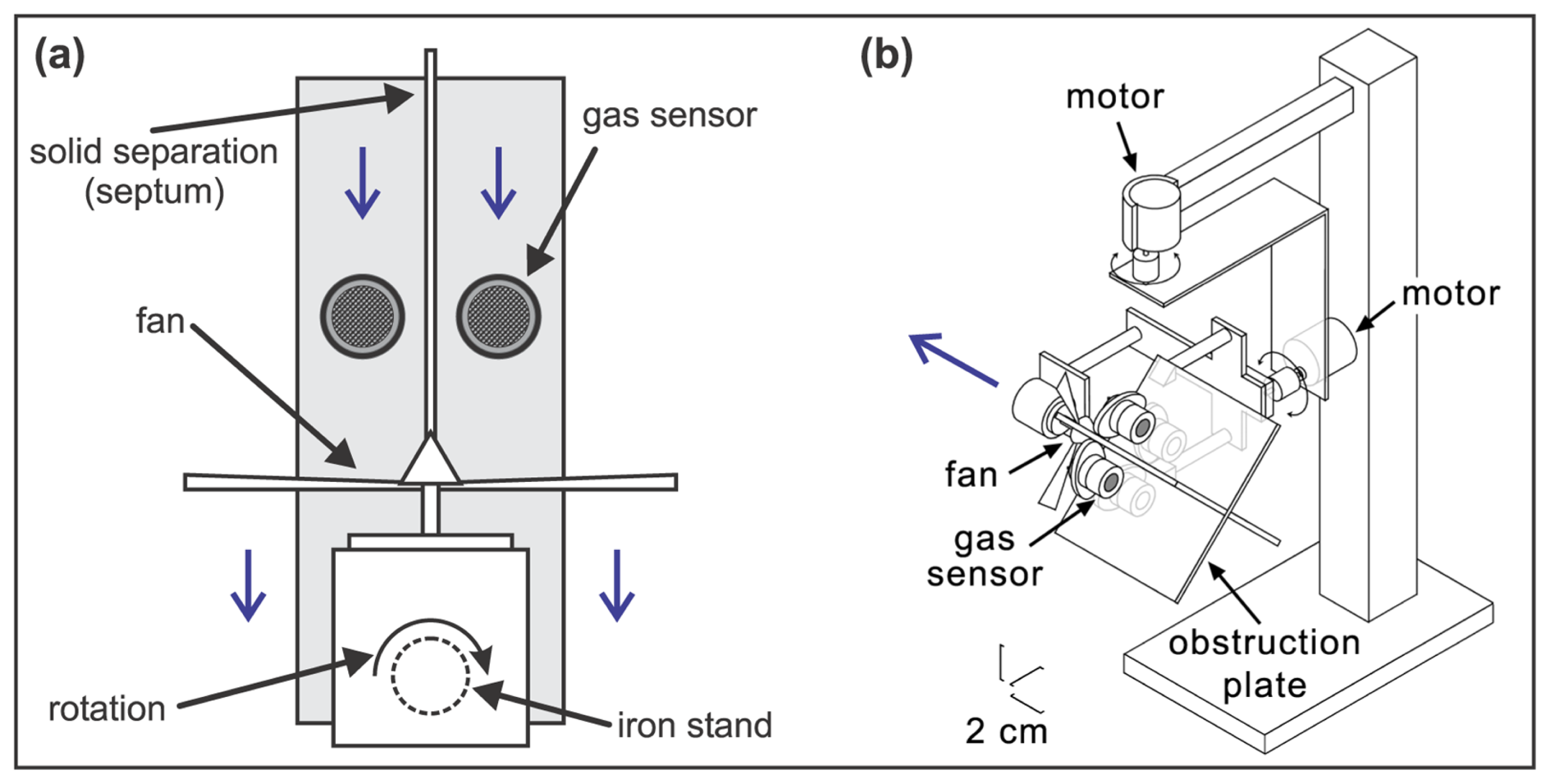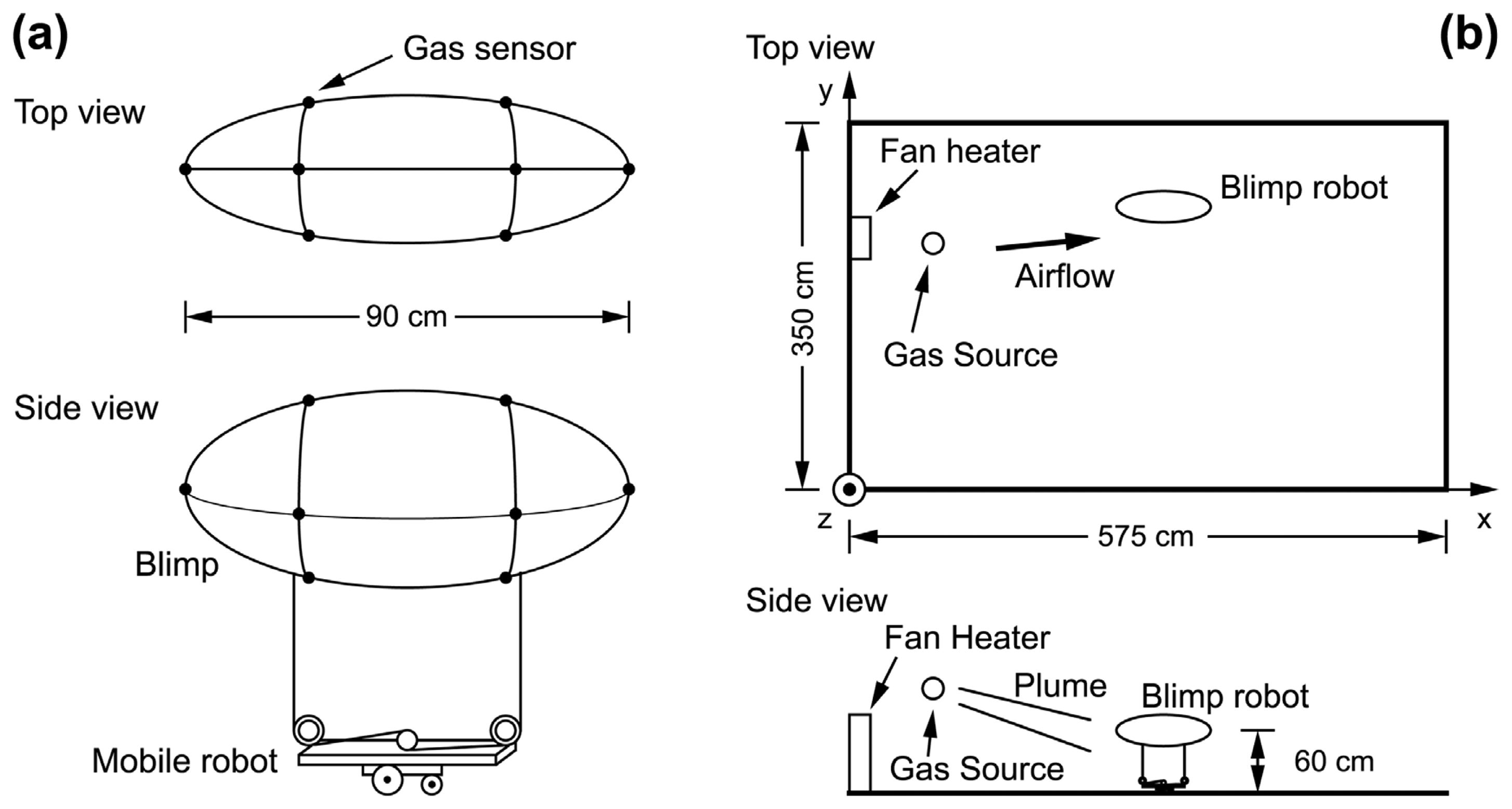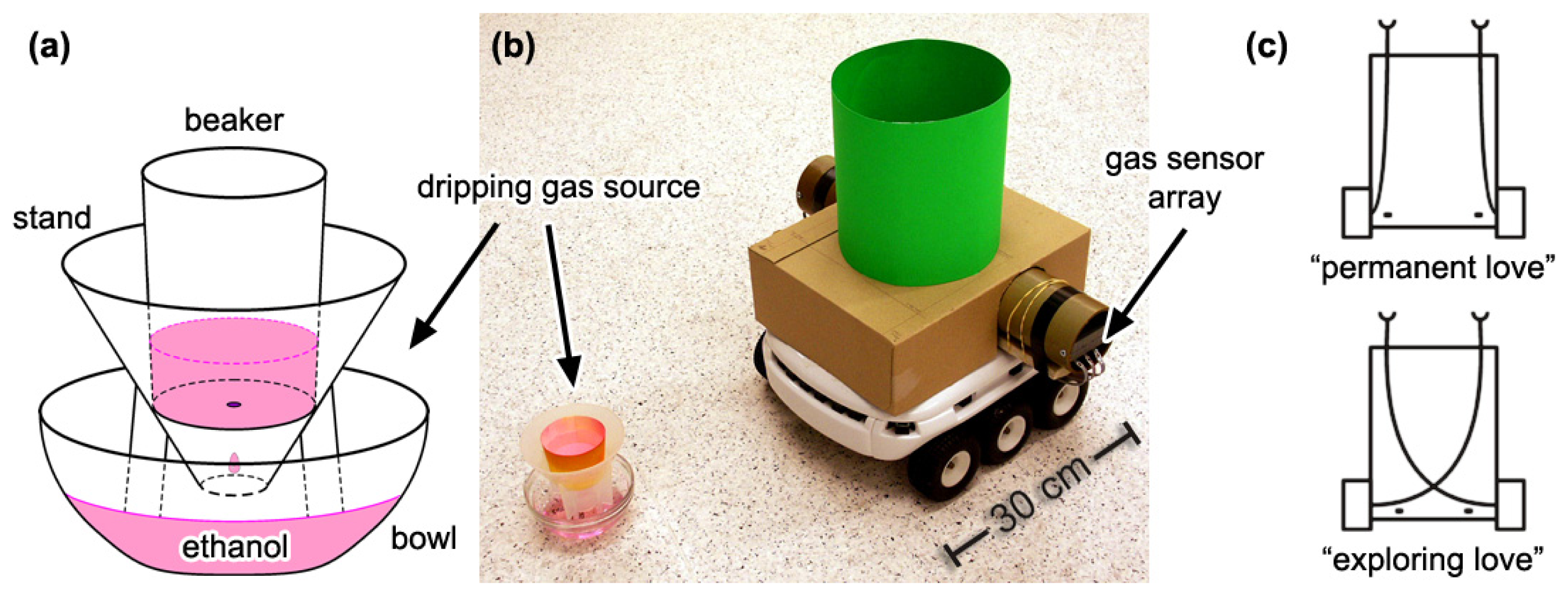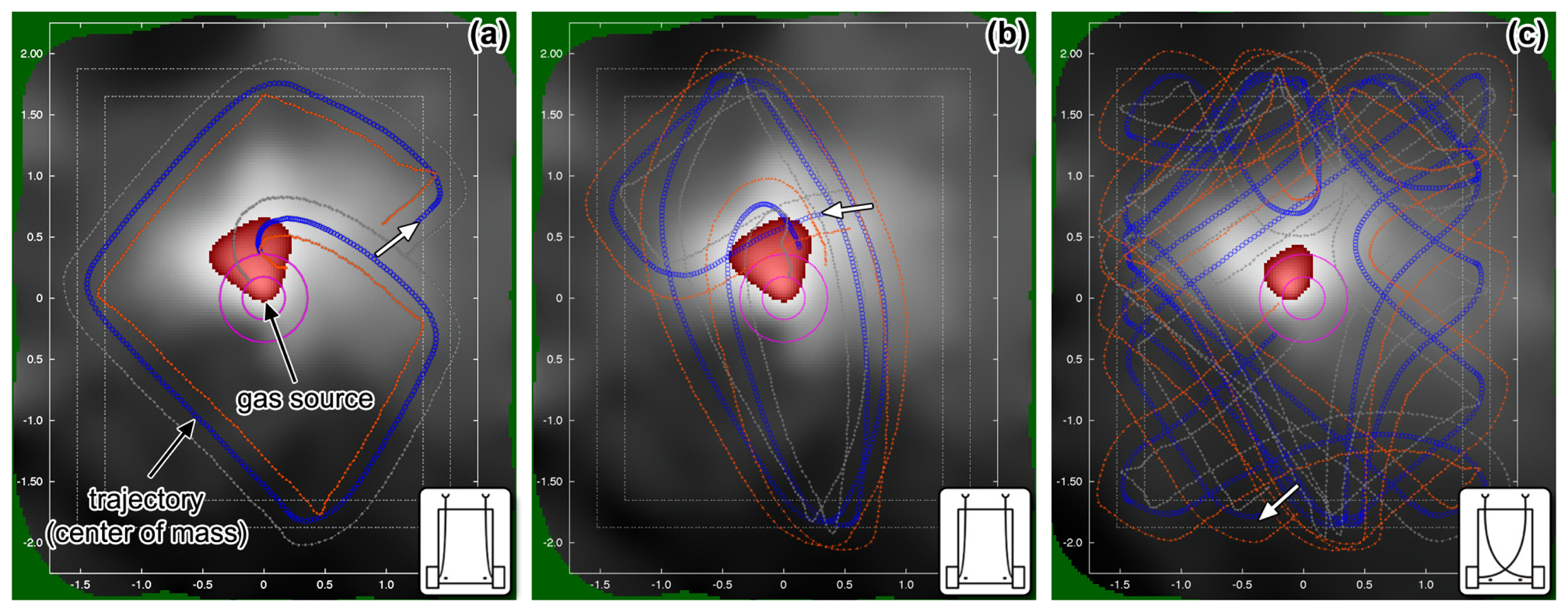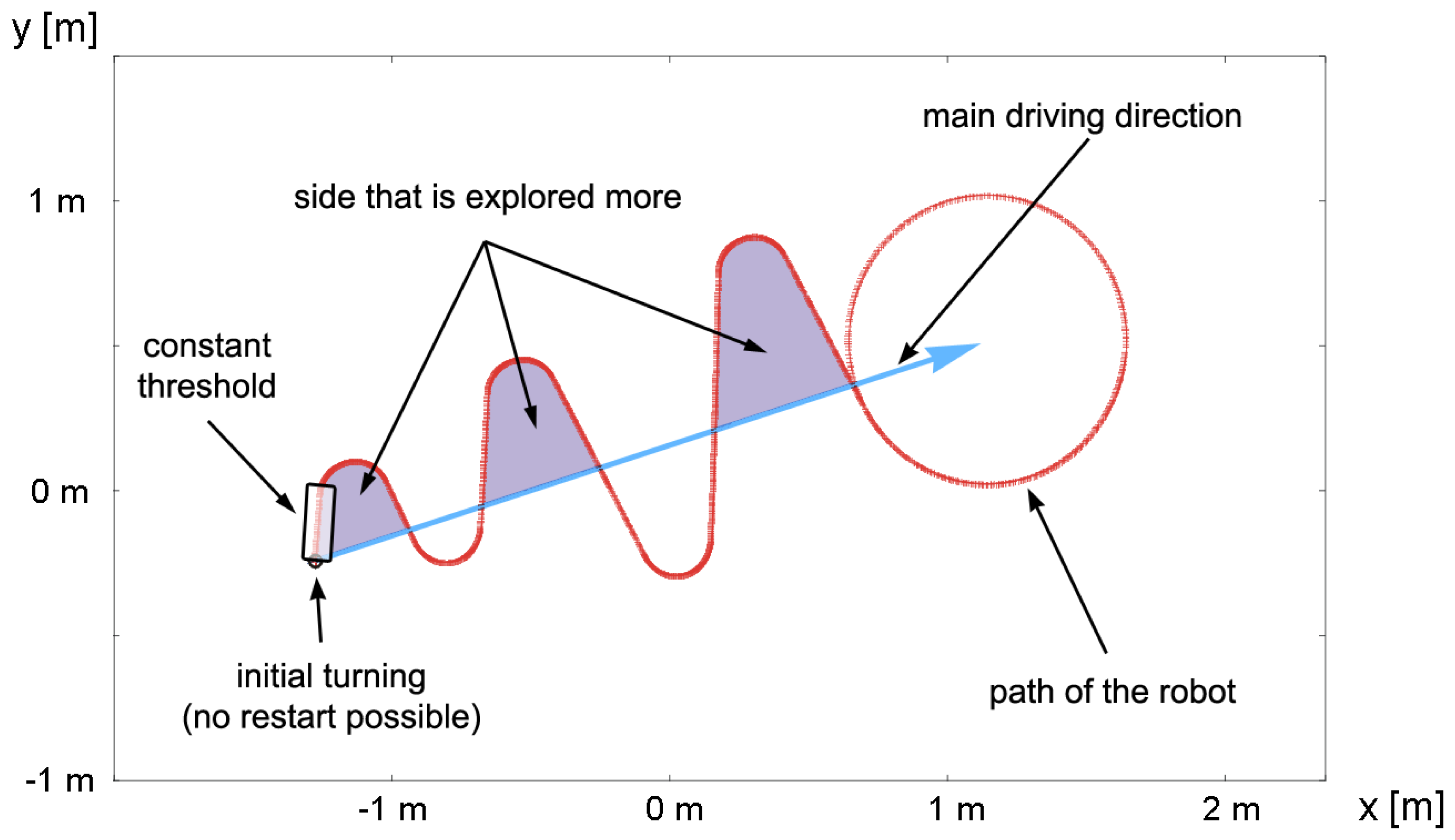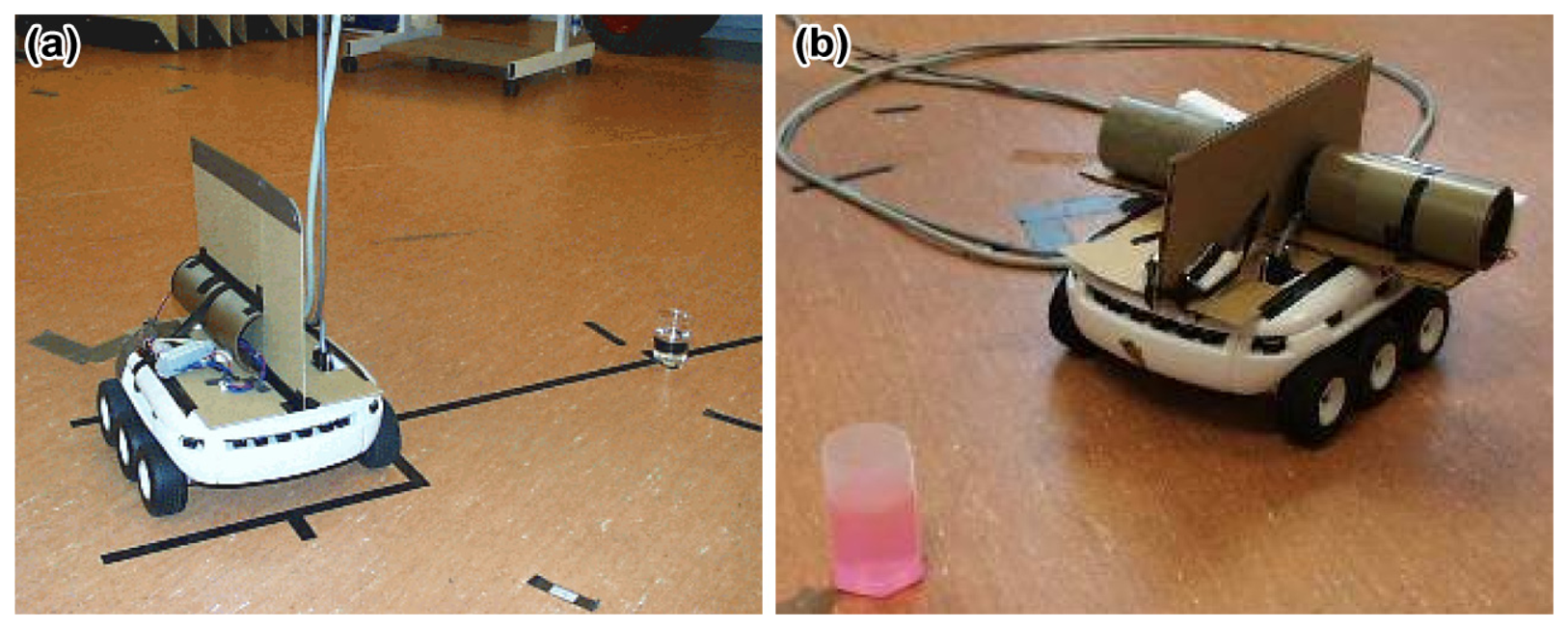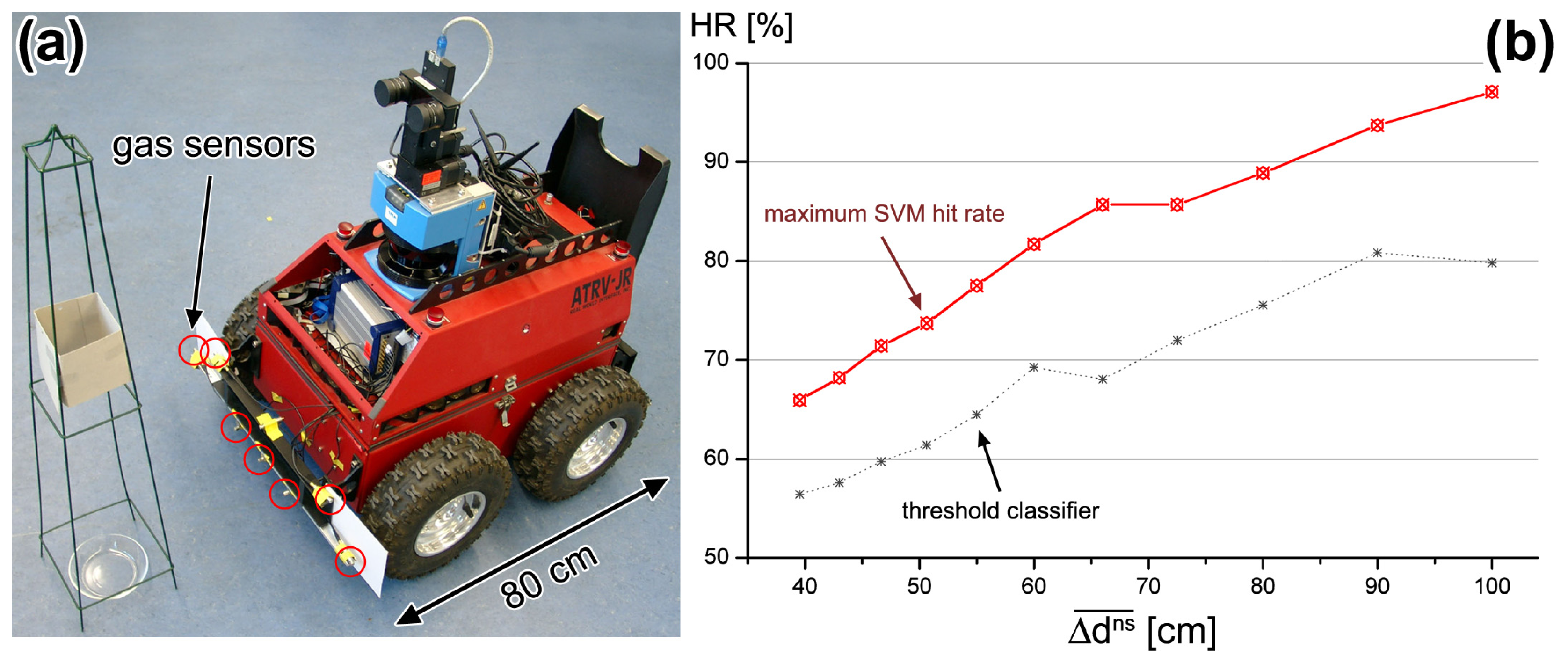1. Introduction
In the future when robots will be part of our daily lives in the domestic environment and at the workplace, surveillance of the ambient gas concentration could be performed by mobile robots that are equipped with an artificial sense of smell. This is especially desirable in a number of different applications in security, surveillance, humanitarian demining, and search and rescue. To endow such robotic systems with the sense of smell, gas sensing devices will need to be integrated into these robotic platforms. Among other qualities, it is expected that such gas sensors should be able to detect a variety of different odourants, demonstrate a high sensitivity to these odourants, and respond quickly and robustly in the presence of an analyte gas. In this way, a mobile olfactory robot can perform a number of olfactory related tasks which include navigating to a specific odour source, creating concentration maps of an area, and offering continuous inspection of a large area.
The value of mobile robots with an artificial sense of smell is probably most apparent in the case of gases that cannot be sensed by humans. Carbon monoxide, for example, is responsible for a large percentage of the accidental poisonings and deaths reported throughout the world each year [
1,
2]. Since it is odourless, colourless and nonirritating, carbon monoxide is impossible to detect by an exposed person. It is therefore known as the silent killer [
3]. Further, it has been suggested that prolonged exposure to low concentrations of carbon monoxide may have subtle adverse effects on the brain [
4], typically without producing directly perceptible health effects. Accidental carbon monoxide poisoning can be caused by a fire, inadequate ventilation or obstructed furnaces. The most straightforward way to compensate for our lack of sensitivity to this gas is the installation of stationary carbon monoxide detectors. While the use of carbon monoxide alarms is certainly recommended, a stationary installation can entail problems especially when measuring low concentration levels since carbon monoxide alarms are sensitive to environmental conditions and location [
1]. With respect to the dependency on the sensor location, a mobile installation has the advantage of a larger coverage and allows for an economical use of gas sensors since they are needed only once per robot instead of once for each designated location. This is particularly advantageous if several gas sensors are required to monitor other pollutants or gases that interfere with the target gas.
One should bear in mind that pollution monitoring tasks need not necessarily be performed by dedicated inspection robots. Instead, surveillance of the ambient pollutant concentration can be carried out by mobile robots that are primarily intended for other tasks. Future service robots, security robots and entertainment robots will share our habitat to a great extent. Combining their mobility with a set of suitable gas sensors presents the opportunity to monitor pollutants in a large percentage of our living space. The capability to monitor the ambient pollutant concentration will improve the value of these robots since, in addition to their other benefits, they can protect the health of their owners by attending continuously to unhealthy environmental conditions. This will naturally reduce the chance of missing places where a risk of hazardous gas was not expected.
The integration of an artificial sense of smell into mobile robotic systems is non-trivial. Investigation of the corresponding challenges has been a growing topic in robotics for the past 15 years. The technological progression of compact gas sensors is integral to the solution of detecting odours with mobile robots and much development is still needed before the gas sensors are satisfactory for real applications. Nonetheless, the integration of olfactory sensing for mobile robots has introduced a number of key research topics for mobile robotics whose investigations can progress in parallel to the sensor development. This article provides a review of these topics, which include gas distribution mapping, trail guidance, and the different subtasks of gas source localisation. It is confined to works on airborne chemical sensing with mobile robots, thus not referring to olfactory experiments with underwater robots, for example. We also do not consider publications that are purely based on simulations, since gas distribution in a real world environment is very difficult, if not impossible, to model faithfully with currently available simulation techniques.
There are already some articles that review different aspects of the field of mobile robot olfaction [
5], [
6], [
7], and a book has been published on the subject [
8]. In this article, we present a comprehensive overview that differs from the previous reviews in several ways. First, a different perspective is adopted, reflected in the structure of the presentation, that was chosen according to our conceptual separation of the different olfactory tasks. Second, we believe that accurate description of the environmental conditions under which olfactory experiments have been carried out is essential to enable meaningful comparisons between individual experiments. Therefore, special attention has been paid to describe the relevant environmental parameters as accurately as possible. We consider a thorough description of the experimental realisation to be very important, since the main components (environmental conditions, hardware design, sensing strategy and the algorithm for signal processing) cannot be studied in isolation, and often the tweaks that have to be made to an implementation are as important to the success of the implemented strategy as the underlying concept. Accordingly, this review article is considerably longer than its predecessors. Finally, it was felt that research in the field of airborne chemical sensing with mobile robots has made substantial progress during the last few years, which is understandably not reflected in earlier reviews.
1.1 Gas Source Localisation
Apart from the detection of an increased gas concentration, the task of localising a source of gas is very important. Providing robots with this ability is needed for applications such as a “smelling electronic watchman” that is able to indicate and locate dangerous gas leaks, leaking solvents or a fire at its initial stage. Assuming the existence of suitable gas sensors in the future, further possibilities could include automatic humanitarian demining [
9] or localisation of the victims of an avalanche. Inspired by solutions found in biological systems, it has also been suggested to use self-produced odours to aid navigation [
10,
11] and for communication with other robots [
12].
Gas source localisation, however, is an intricate task under natural conditions due to the turbulent nature of gas transport, which leads to a patchy, quickly fluctuating gas distribution. The corresponding concentration field does not guide the way to its source by means of a smooth concentration gradient and does not necessarily indicate the source location by a maximum of the instantaneous concentration distribution (see Section 3). While the gas source localisation problem is very challenging, it nonetheless deserves study since it is the key to many significant applications. In addition, investigating gas source localisation strategies can be expected to lead to a deeper understanding of the physical properties of turbulent motion, as well as the way in which animals use odours for navigation purposes.
1.2 Gas Source Localisation Taxonomy
The gas source localisation problem can be broken down into three subtasks [
13]:
gas finding - detecting an increased concentration of a target gas,
gas source tracing*- following the cues determined from the sensed gas distribution (and eventually using other sensor modalities) towards the source,
gas source declaration - determining the certainty that the source has been found.
This classification follows a suggestion of Hayes et al. [
14], with the difference that the existence of a sufficiently strong and constant airflow is not presumed. Such conditions allow the identification of a plume from the gas distribution which can be followed to its origin. The term “plume” refers to an aerial trail of gas which has a shape that resembles the shape of a feather [
15]. However, a discernible gas plume can not be guaranteed, for example, in an unventilated indoor environment.
The introduced taxonomy provides a useful conceptual framework for classifying gas source localisation strategies, but approaches do not have to address the subtasks independently. An example could be a set of reactive behaviours that causes the robot to explore a certain area as long as no increased concentration is detected and moves the robot closer to the gas source if the sensed concentration exceeds a certain threshold. Such a set of behaviours can address both subtasks, gas finding and gas source tracing, without it being possible to associate each subtask with a separate subset of behaviours. It should also be noted that a complete gas source localisation strategy does not necessarily involve some sort of source tracing if it implies a means of deducing the location of the gas source from a distance.
It should be emphasised that suggestions for gas source localisation may not rely only on gas sensor measurements. Temperature or humidity sensors can provide additional cues to localise certain types of gas sources. In the case of a reasonably unidirectional airflow, the local upwind direction can serve as an estimate of the direction to the gas source. Air flow measurements can further be used for more efficient gas finding and gas source declaration strategies, and a vision system might indicate candidate objects for subsequent investigation using a gas source declaration strategy.
1.3 Gas Finding
While most of the publications in the field of airborne chemical sensing with mobile robots are concerned with gas source tracing, little attention has been paid so far to gas finding and gas source declaration. Solutions to these problems are required in addition to gas source tracing strategies in order to provide a complete solution to the gas source localisation problem. However, they are also important in other contexts, for instance when only the presence of a gas source has to be detected (gas finding) or when the task is confined to determining whether a given object is a gas source or not (gas source declaration).
An appropriate gas finding strategy is sufficient for surveillance applications where a mobile robot is only supposed to trigger a general warning when detecting a specific gas, without providing more detailed information. Apart from a suitable sensor set-up, the problem of gas finding requires mainly to select an appropriate exploration strategy and to define a threshold value above which the target gas is assumed to be present. Generally, this threshold value needs to be adaptive to compensate for varying environmental conditions or sensor drift, for example. A suitable exploration strategy for gas finding has to take into account the additional complexity that a simple sequential search is not guaranteed to succeed due to the stochastic nature of the plume [
16].
1.4 Gas Source Declaration
The fundamental problem for gas source declaration using only the sense of smell is to find regularities in a turbulent concentration distribution which make it possible to decide whether a certain area contains a gas source or not. The most straightforward feature to look for is a local concentration maximum. In order to derive a meanigful indicator for gas source declaration, the time-averaged concentration distribution has to be considered. Searching for maxima in the instantaneous concentration field is of little help since they are often found far away from a source. Whether a turbulent gas distribution provides further regularities that allow for reliable gas source declaration is an exciting question that cannot be answered conclusively at the moment. It is very difficult to derive the general features required in the turbulent fine structure from the equations that describe turbulent gas spread and it is possible that the bandwidth of commonly used gas sensors might not be sufficient to resolve these features.
Using wind sensors in addition to gas sensors can be helpful in the context of gas source declaration if the airflow is strong enough to be measured reliably. In this case a correlation between airflow direction and the measured concentration can be used to declare a gas source, for example, by determining a drop between the concentration measured in downwind and upwind direction.
Having a reliable gas source declaration strategy can be sufficient to address gas source localisation even if the full problem cannot be accomplished using gas and wind sensors only. An object could first be located using other sensor modalities (a vision system, for example), and then classified using the gas source declaration method. Such a procedure assumes that candidate gas sources can be perceived with the additional sensor modality. Assuming the availability of sufficiently sensitive gas sensors, possible applications include the identification of suspicious items containing illegal narcotics or explosive materials, and employment in rescue robots to determine whether a victim is still alive by measuring their carbon dioxide output.
1.5 Gas Distribution Mapping
Another issue that has not yet been considered extensively is gas distribution mapping. In addition to the temporally fluctuating character of turbulent gas transport, it has to be taken into account that chemical gas sensors only provide information about the small volume of gas that their surface interacts with. It is therefore impossible to measure the instantaneous concentration field without using a dense grid of sensors. However, it is often sufficient to know the time-constant structure of a gas distribution. This might even be more important than knowing the exact location of gas sources, for example, because it allows to determine areas in which high concentrations of a harmful gas are to be expected. Mobile robots that are able to map the gas distribution in a contaminated area could be used in rescue missions by incident planning staff to prevent rescue workers from being harmed or killed by explosions, asphyxiation or toxication [
17]. Other applications for gas distribution mapping include air quality monitoring and surveillance of pedestrian areas in cities, and precision farming [
18], where the average distribution of particular gases could be used as a non-intrusive way of assessing the soil condition or the status of plant growth to enable a more efficient usage of fertiliser.
Creating a map of the average concentration of a target gas also provides a means of addressing the gas source localisation problem. However, this approach has some drawbacks. First, it is required that the environmental conditions and the activity of the gas source do not change drastically within the time frame of the mapping process. Second, gas source localisation methods based on gas distribution mapping can be slow due to the time it takes to build a reliable representation of the average concentration in which turbulent fluctuations are sufficiently “averaged out”. On the other hand, the time consumption scales down with the number of robots utilised with a lower bound that is theoretically given by the time required to compensate for turbulent fluctuations with a dense grid of sensors. A further advantage is that the information about the concentration distribution in the whole inspected area may be used to increase the accuracy and the certainty of the gas source location estimate.
1.6 Outline
The rest of this article is structured as follows. First, a brief summary of gas sensor types that have been used with mobile robots, is given in Section 2. Next, the peculiarities of machine olfaction in a natural environment are discussed in Section 3. Then, an overview of early work on gas-sensitive robots is given in Section 4, followed by a classification of literature in the field of airborne chemical sensing with mobile robots in Section 5. Using this classification as a guideline, the following sections review approaches to gas distribution mapping (Section 6) and trail following (Section 7), suggestions for gas finding (Section 8), work on gas source tracing with and without the assumption of a strong constant airflow (Sections 9, 10, and 11), and approaches to the full gas source localisation problem based on analytical models (Section 12). Finally, an overview of the work on gas source declaration is provided (Section 13) followed by conclusions and and a discussion of open questions (Section 14).
3. Gas Sensing in a Natural Environment
Electronic noses have been studied extensively under laboratory conditions. Numerous publications are available, for example, in the field of food analysis. To name only a few, this includes tests on the freshness of fish [
42], quality estimation of ground meat [
43], recognition of illegally produced spirituous beverages [
44] and discrimination of different coffee brands [
45].
These results cannot be obtained in the same manner when using a mobile robot due to the influence of varying environmental conditions and restrictions because of limited resources such as power and the available space, for example. An important aspect that is difficult to transfer to a mobile system is the sample handling process. In most laboratory-based applications (see
Fig. 1 for example) much effort is expended to prepare the volatile components before they are analysed with the gas sensor system. Typically headspace samplers are used, which prepare a defined sample of evaporated material (the so-called headspace) and deliver the sample in a well defined way to a chamber that contains the gas sensors [
46]. Moreover, best performance was achieved in laboratory experiments by using a measurement technique that requires a second gas (e.g. clean air with known humidity), which is periodically routed to the sensor chamber. It serves as the carrier gas for the headspace sample and as a reference for tracking the baseline level of the sensor response. Due to the demand for real-time operation and restrictions of weight, space and power consumption it is usually not feasible to establish the same sophisticated sample handling process on a mobile robot.
As a consequence of the limited resources it is also difficult to achieve sufficiently stable environmental conditions. Gardner and Bartlett report typical accuracies of ±0.1°C temperature, ±1% relative humidity and ±1% flow rate as important conditions when employing electronic nose technology [
24]. For application on a mobile robot, larger variations in the environmental conditions have to be tolerated. Consequently, research in the field of airborne chemical sensing with mobile robots has focussed so far mostly on using gas sensors for detection of a known target gas and localisation of the gas source rather than discrimination of different gases. To avoid confusion, a complete gas-sensitive system used on a mobile robot is sometimes referred to as a “mobile nose” [
47].
3.1 Gas Distribution in a Natural Environment
A major problem for gas source localisation in a natural environment is the strong influence of turbulence on the distribution of gas. Turbulent transport generally dominates the dispersal of gas due to molecular diffusion. For example, the diffusion constant of gaseous ethanol at 25°C and 1 atm is D = 0.119 cm
2/s, corresponding to a diffusion velocity of 20.7 cm/h [
48]. Apart from very small distances where turbulence is not effective and diffusion can be distinct along steep concentration gradients, molecular diffusion can thus be discounted as a major factor concerning the spread of gas.
Turbulent flow exhibits several general characteristics described below (following the summary by Roberts and Webster in [
50]). First, turbulent flow is unpredictable. Turbulence is chaotic in the sense that the instantaneous velocity (and consequently also the instantaneous concentration of a target gas) at some instant of time is insufficient to predict the velocity a short time later.
Second, as mentioned above, turbulent transport is considerably faster than molecular diffusion. This is indicated in
Fig. 2, which shows colour-coded concentration distribution in simulated gas mixing due to the effect of diffusion alone (bottom, left) and due to diffusion and turbulence (bottom, right). The pictures in the lower part of the figure show snapshots of the gas distribution that evolved from the circular distribution depicted in the upper part. These distributions were obtained by Smyth and Moum by means of a numerical solution of the equations of motion [
49]. It is apparent from the figure that turbulent flow causes a much quicker spreading of the target gas. As an average effect this can be modelled by defining an effective turbulent diffusion coefficient (the eddy diffusivity, see for example [
51]).
Third, a turbulent flow comprises at any instant a high degree of vortical motion. These continuously fluctuating eddies range in size from the largest geometrically bounded scales of the flow (the so-called integral length) down to the scales where only molecular diffusion is effective (Kolmogorov microscale). While large scale eddies cause a meandering dispersal, small scale eddies stretch and twist the gas distribution, resulting in a complicated patchy structure (see
Fig. 2). The instantaneous distribution exhibits no smooth concentration gradients that indicate the direction towards the centre of the gas source. Assuming reasonably stable conditions such as uniform and steady flow, however, the time-averaged concentration field varies smoothly in space with moderate concentration gradients.
A fourth characteristic of turbulence is the dissipation of kinetic energy. Turbulent kinetic energy is passed down from the largest eddies to the smallest, where it is finally dissipated into heat by viscous forces (this is called the energy cascade). The magnitude of the viscous forces determines the minimal eddy size (Kolmogorov microscale, see [
8,
50] for details).
Another important transport mechanism for gases occurs due to the fluid flow itself (advective transport). This mechanism is typically effective even in an indoor environment without ventilation due to the fact that weak air currents exist as a result of pressure (draught) and temperature inhomogeneities (convection flow).
In summary, the instantaneous concentration field of a target gas released from a static source is a fluctuating typically asymmetrically shifted distribution of intermittent patches of high concentration with steep gradients at their edges. These properties are illustrated in
Fig. 3, which shows typical sensor readings in the vicinity of a gas source (evaporating liquid ethanol). In this experiment taken from [
52], the robot passed the source along a straight line at a low speed of 0.25 cm/s in order to measure the distribution of the analyte gas accurately. Despite the smoothing effect due to the slow recovery of the metal oxide gas sensors used, the curve in
Fig. 3 reveals the existence of many local concentration maxima. Moreover, the absolute maximum was found approximately 70 cm away from the actual location of the gas source. It is a very typical result that the location of the gas source and the absolute maximum do not coincide if the gas source has been active for some time (naturally, if the gas source has just been “opened”, the highest concentration must occur close to the surface or the outlet of the source). On one hand, this can be attributed to the fact that even for a gas sensor which is located directly over or under the gas source, the molecules of the analyte gas have to travel some distance to reach this sensor if it is not mounted level with the gas source. On the other hand, it is also a consequence of the fairly constant concentration in isolated gas patches which changes slowly with time – and therefore also with spatial distance from the source – and does not depend strongly on the average concentration. In the case of turbulent diffusion from a small source, the peak concentration values are generally an order of magnitude higher compared to the time-averaged values [
50].
9. Gas Source Tracing With a Strong Airflow
Chemical trails marked on the ground form a relatively stable concentration profile in the vicinity of the trail. The signal processing part of the problem of trail guidance is the detection of the transition between a chemically marked area and its unmarked vicinity from sensor readings obtained at a low distance from the ground. In a real-world gas source tracing scenario, the task is to extract information about the location of a distant gas source from local concentration measurements sampled from a turbulent gas distribution.
Because chemical stimuli are not inherently directional, this information has to be derived from at least two spatially or temporally distributed samples. When reliable information about the airflow is available, the local upwind direction can additionally be used as an indication of the direction to the source. For this reason, many proposed solutions to the problem of gas source tracing assume a strong unidirectional airflow that enables two step strategies, combining gradient-following (tropotaxis) and periods of upwind movement (anemotaxis). This section summarises gas source tracing methods that were tested under the condition of a strong unidirectional airflow, i.e. in a scenario with a discernible gas plume. As with all the experiments in the field of airborne chemical sensing with mobile robots published so far, these experiments were all carried out indoors.
Ishida et al. were the first to integrate gas and wind sensing capabilities on a mobile robot. In [
76] they introduced a remotely controlled mobile platform equipped with a probe consisting of four thermistor anemometric sensors and four metal oxide gas sensors (TGS 822), shown in
Fig. 11. The wind sensors were mounted around a square pillar with a spacing of 90°, thus making it possible to obtain information about the direction of the airflow. Ideally, the direction of the sensor with the lowest output should correspond to the downwind direction since the wind is obstructed by the pillar. The gas sensors were mounted on top of the pillar, each located straight above one anemometric sensor. With this experimental platform, two different plume tracing methods were tested in a small wind tunnel (0.7 × 0.8 × 0.35 m
3). The gas source was provided by a nozzle that spouted ethanol gas at a rate of 150 ml/s, and an average wind speed of approximately 20 cm/s was generated by a fan.
9.1 Step-by-Step Progress Method
The idea of the step-by-step progress method is to follow the concentration gradient towards the centre of a gas plume and to move upwind at the same time. Since the concentration gradient is usually much higher across the wind direction than along the wind direction, only the gas sensors perpendicular to the wind direction were considered to determine the concentration gradient (see
Fig. 12 (a)). The wind direction was determined with an accuracy of 90° by selecting the anemometric sensor with the lowest output and the intermediate angle between the wind direction and the gas sensor with the larger response was chosen as an approximation to the direction of the gas source. Then, the robot was driven a small distance (2 cm) in this direction. This procedure was repeated until the robot reached the edge of the wind channel (the source was placed outside the wind channel).
Because the concentration gradient across the wind direction was often found to be misleading with very low gas concentrations, a waiting period had to be introduced. The robot was stopped when both of the “across-wind” sensor readings fell below a fixed threshold. With this additional mechanism, the step-by-step progress method was found to be successful under different conditions created by halving the spouting rate of the gas source to 75 ml/s and/or reducing the wind velocity from 20 cm/s to 12 cm/s. The speed of the robot when performing the steps was approximately 1 cm/s.
9.2 Zigzag Approach Method
Another method tested by Ishida and co-workers with the set-up shown in
Fig. 11 is based on the idea of crossing the plume repeatedly at an angle to the upwind direction until the edge of the plume is detected (zigzag approach method). It was implemented as follows: first, the robot is rotated to an angle of
α = 60° with respect to the upwind direction and moves along a straight line until it detects the beginning of the plume. The robot carries on driving in a straight line until it detects the end of the plume, and then rotates back to an angle, which is alternately set to
−α and
α with respect to the upwind direction. In the experiments, the upwind direction was determined with an accuracy of 45° from the response pattern of the anemometric sensors.
The robot was considered to be in the plume if the gas sensor readings exceeded a fixed threshold. It was found necessary, however, to add a mechanism to cope with cases where the robot moved out of the plume due to spurious turns caused by fluctuations in the sensor readings. This mechanism was implemented as a backtracking movement that was triggered when the sensor readings fell below a fixed threshold. With this additional mechanism, the zigzag approach method was also successful in tracing the plume of the gas source in the sense that the robot reached the end of the wind channel approximately level with the source.
Apart from a demonstration of the general feasibility of the suggested methods under the condition of a strong unidirectional airflow, the experiments discussed in Sections 9.1 and 9.2 indicate the importance of a mechanism to deal with erroneous decisions that occur due to the turbulence of the airflow.
9.3 Plume-Centred Upwind Search
A gas source tracing strategy for a mobile robot with a single gas sensor and a wind measuring device was proposed by Russell et al. [
77]. It is sketched in
Fig. 13 (a). The strategy was implemented on a wheeled robot that was equipped with a single QMB sensor and a wind vane to measure the direction of the airflow. First, the robot tries to find the centre of the gas plume. This is achieved by recording the concentration profile while the robot moves across the wind direction. When the robot reaches the far side of the plume (indicated by a sensor reading that falls below a certain threshold), it returns to the calculated centre of the plume and turns into the upwind direction. Then, the plume tracing phase is started, which is similar to the step-by-step progress method discussed above. To maintain a path close to the centre of the plume, the robot corrects its heading after each step (the step length was 0.35 cm in the experiment) according to the concentration gradient across the wind direction, which is sensed by turning the robot 90° to the left and right, respectively.
Russell et al. report two successful trials in a corridor with a unidirectional airflow of approx. 30 cm/s where people occasionally walked past the robot during the experiments. The robot was able to follow the gas plume over a distance of approximately 1 m with and without an obstacle inbetween the gas source and the point where the tracing phase was started. In the experiments, a remarkably strong gas source was assembled from a number of short sections of cardboard mailing tube glued together, which were then sprayed with a solution of camphor dissolved in alcohol immediately before each experiment. The camphor plume was created by a fan that generated an airstream through the open-ended tubes.
Biological Inspiration: Upwind Movement and Local Search
Further proposed solutions to the gas source tracing problem draw inspiration from the observation of biological systems that apply a combination of anemotaxis and chemo-tropotaxis. A well investigated example is the gas source tracing behaviour of moths. Male moths are able to localise their females who release a specific pheromone over large distances. They are believed to use a rather simple behaviour which does not involve memory or learning, but are still able to cope with the intermittent structure of the pheromone plume. In particular the gas source tracing behaviour of the silkworm moth
Bombyx mori is well-investigated and suitable for adaptation on a wheeled robot, because this moth usually does not fly [
78]. The behaviour consists of a programmed motion sequence that is (re-)started whenever a patch of pheromones is detected. It serves as an oriented local search for the next pheromone patch. In the case of
Bombyx mori, it consists of an initial forward surge in upwind direction, followed by a side-to-side search (performed with increasing amplitude) and a final looping motion [
79].
Kuwana et al. developed an experimental set-up that enables comparison of gas source tracing strategies implemented on a mobile robot with the tracing behaviour of a real moth under the same conditions [
80]. In order to achieve a high degree of comparability, a gas source tracing behaviour was implemented on a small robot with a similar size to the real moth, and living antennae taken from a moth were utilised as a pair of gas sensors [
81]. However, a comparison with a robot controlled by an algorithm that mimics the behaviour of the moth has not yet been published by Kuwana and co-workers. Rather, an experiment is reported with a robot controlled by a simple reflex-based program, which performs chemo-tropotaxis without using information about the local wind vector. With this simplistic strategy, the robot could trace a pheromone source over a distance of 10 cm in a wind tunnel with a wind speed of 25 cm/s. While a real moth could localise the pheromone source very precisely in this environment, the robotic moth missed the source in the reported trial by almost 2 cm and did not stop after passing the pheromone source [
80].
The particular strength of the sophisticated experimental set-up developed by Kuwana et al. is that it allows to compare different gas source tracing strategies with the performance of a biological organism using similar “hardware”. Unfortunately, this strength was not exploited to its full extent so far, which may be partly due to experimental difficulties, for example, the limited lifetime of the gas sensors of only 60 minutes. Nevertheless, the experiments by Kuwana et al. highlight the significant potential for gaining a deeper understanding of the way animals use odours for navigation purposes through comparison of the performance of a biological system with an implementation on a mobile robot.
9.4 Silkworm Moth (Bombyx mori) Algorithm
A gas source tracing strategy that actually mimics the behaviour of the moth
Bombyx mori was implemented by Russell and co-workers [
75]. A mobile robot was equipped with two polymer gas sensors and a wind measuring device, consisting of a small rotating paddle and an optical encoder to measure the rotational speed of the paddle [
82]. From the variation in the rotational speed of the paddle both the wind velocity and wind direction were determined. The circular robot with a diameter of 10 cm had a similar construction to a Logo Turtle. The experimental environment was the top of a table tennis table (2.7 × 1.5 m
2). A fan that produced an airflow of approximately 1.5 m/s was situated 2.8 m from the point where the robot was started and approximately 1 m from a bubbler gas source, a flask filled with an analyte solution (5% ammonia solution in this case) through which air is bubbled by a pump.
The
Bombyx mori behaviour was implemented in an iterative manner (see
Fig. 13, b). First, the robot turns towards the wind direction and waits until it detects an increased gas concentration. Upon detection of the analyte, a local search is carried out, consisting of a forward step and a zigzag movement. Then, the robot turns again towards the wind direction and moves fowards and backwards along a circle, starting in the direction of the sensor that was first stimulated. The individual parts of the motion sequence were carried out on the same scale as the size of the robot. After each step, if another patch of gas is detected then the local search is restarted from the beginning. When receiving no stimulation during the full motion sequence, the algorithm returns to the initial waiting phase.
9.5 Dung Beetle (Geotrupes stercorarius) Algorithm
In addition to the behaviour of the silkworm moth, another biologically inspired gas source tracing strategy that uses wind information was tested with the table tennis set-up by Russell and co-workers [
75]. The algorithm is modelled on the behaviour of the dung beetle
G. stercorarius (see
Fig. 14, a). It is similar to the zigzag approach method discussed in Section 9.2. The robot zigzags back and forth across the plume and turns when the concentration drops below a threshold, which is assumed to indicate the outer edge of the plume. As in the silkworm moth algorithm, the dung beetle behaviour was implemented in a stepwise way, discretising the zigzag movement into 50 cm steps.
9.6 Escherichia coli Algorithm
Two further gas source tracing strategies that do not use information about the wind direction were tested with the table tennis set-up under the condition of a strong airflow [
75]. The
E. coli algorithm consists of straight “runs” and direction randomising “tumbles”. It was implemented as a sequence of straight steps after which either a small rotation (randomly chosen from [−5°,5°]) is performed if the current sensor reading is higher than the previous one, or the robot is turned by a larger angle (randomly chosen from [−180°,180°]) in the case of decreasing stimulation. Thus, the runs tend to be straighter if the sensed concentration increases while a high “tumbling frequency” equivalent to an unbiased random walk is applied otherwise.
9.7 Iterative Chemo-Tropotaxis
In contrast to the E. coli algorithm, which requires only a single gas sensor, the fourth strategy tested with the table tennis set-up was an iterative version of reactive gradient-based control (iterative chemo-tropotaxis). It was implemented as a sequence of two repeatedly executed steps. The robot moves forward for a set, small distance (2 cm) and then rotates by an angle proportional to the concentration gradient towards the side that was stimulated more (the maximum turn angle per step was ±16°).
Comparison of Results for the Table Tennis Experiments
Due to the high wind speed of 1.5 m/s, the concentration gradient along the gas plume was small. As a consequence, it was found that the iterative chemo-tropotactic strategy (Section 9.7) could not distinguish whether the robot was moving towards or away from the gas source. Thus, the algorithm failed in all of the ten trials where the robot was started facing in downwind direction. In contrast, five out of ten trials where the robot was started in upwind direction were successful in the sense that the robot finally collided with the gas source.
A convincing gas source tracing behaviour could not be achieved with the E. coli algorithm (Section 9.6). This can be attributed to the sensitivity of the algorithm to deviations from a smooth gradient, which apparently must exist in a turbulent concentration field.
A higher success rate of 70 % was found in ten trials with the silkworm moth behaviour (Section 9.4) where the robot was started from the same position as in the experiments with the iterative chemotropotactic strategy. The same success rate of 70 % was also observed in another ten trials where the dung beetle strategy (Section 9.5) was applied.
The observed mean path length of successful trials was found to be higher for the dung beetle algorithm (≈ 190% of the shortest path) compared to the silkworm moth algorithm (≈ 130%) and iterative chemo-tropotaxis (≈ 105%). It is, however, difficult to compare these results because of the small number of trials and because different starting positions were used. In general, the result is expected to depend crucially on the choice of the starting position. The silkworm moth algorithm, for example, produced a relatively short path since the local search was usually restarted before the looping phase. A longer relative path length could be expected if the robot was started farther away from the source where patches of gas occur more sparsely. Also the success rate will vary with the tracing distance. While the gradient-based tracing method, for example, was able to quickly acquire and follow the centre-line of the gas plume in the successful trials, it was also found to be more susceptible to failures. It contains no means of recovering from erroneous situations and these situations will occur more frequently at a larger distance from the source where the peak to time-average concentration ratio is higher [
50].
9.8 Spiral Surge Algorithm
The Spiral Surge Algorithm introduced by Hayes, Martinoli and Goodman [
16] is based on the same principle as the behaviour of the silkworm moth. When an “odour hit” is detected, the robot determines the wind direction and moves upwind for a set distance (see
Fig. 14, b). If another odour hit is encountered during the surge, the robot resets the surge distance (but does not resample the wind direction). Next, an outward spiral is performed as a local search for the next patch of high concentration. Remarkably, the Spiral Surge Algorithm uses only binary information from a single gas sensor, based on whether the sensor reading exceeds a fixed threshold or not.
This algorithm was implemented on a group of circular-shaped robots, which were equipped with a hot wire anemometer and a single conducting polymer sensor. The anemometer was enclosed in a tube to enable determination of the wind direction as the direction where the highest wind speed is measured while the robot performs a slow 360° rotation. While determining the wind direction is a rather time-consuming operation due to the scanning movement involved, the fast response time of the polymer gas sensors enabled a comparatively high speed of the robots during the searching behaviour (approximately 30 cm/s). A gas plume was created by a pan of hot water located in one corner of the test arena in front of a bank containing five fans, which produced an airflow of approximately 1 m/s.
Three variations of the spiral surge algorithm were tested in a 6.7 × 6.7 m2 arena. Two variants without (“SS1”) and with the local-search spiral (“SS2”), and a variant of the SS2 strategy to emulate blind upwind searching (“Random Odour”). The “Random Odour” behaviour was implemented through internally generated odour hits, which were recorded from the sequence obtained in the SS2 experiments. Therefore, the robot receives odour hits without correlation to its position in the “Random Odour” trials. As a reference strategy, a random walk behaviour was also implemented and tested where the robot is driven along straight paths performing random avoidance turns at boundaries.
15 trials with each algorithm were conducted for each group size (one to six robots), except for the random walk behaviour, which was run 30 times due to the high variance of the observed path length. A successful trial was assumed when the robot entered a radius of approximately 90 cm around the source.
With the possible limitation that the results may not be all generalisable to lightweight odourous molecules (rather than the relatively massive droplets of water measured in their experiment), the experiments of Hayes et al. demonstrated the suitabililty of the Spiral Surge Algorithm for gas source tracing over a distance of more than 6 m. With high statistical significance the SS2 algorithm was found to perform better in terms of the distance travelled compared to the “random odour behaviour”, indicating that the location where the spiral movement is started is in fact an important aspect of the searching strategy. The shortest tracing paths, however, were obtained with the SS1 strategy. This is interpreted by the authors as an effect of the small test arena, where a local search for the next “odour hit” is not required because a straight surge in upwind direction usually guides the robot towards the source. With increasing group size, the random walk behaviour tends to approach the performance of the SS1 strategy, indicating that a gas source can be best found by chance in an overcrowded area.
9.10 Odour Compass
In connection with the multitude of tracing strategies, another device is to be mentioned that was devised to support the gas source tracing process in a similar way as a magnetic compass supports travelling towards the north pole. A sketch of the two-dimensional “odour compass” developed by Nakamoto et al. [
84] is shown in
Fig. 16, a. It consists of metal oxide gas sensors, a fan and a plate to separate the gas sensors, all situated on a support that is mounted on a rotatable stand. This set-up is biologically inspired. A solid separation is often found in biological noses (septum). Modulating the reception of chemical signals, for example by sniffing, is also a widespread behaviour in the animal kingdom. The use of a fan in the odour compass was particularly inspired by the observation that wing-fanning is important for the gas tracing performance obtained by walking silkworm moths [
84]. As observed in the biological archetype, the fan draws the air towards the gas sensors, which has the effect of an improved differentiation of the response of the gas sensors with respect to the orientation of the odour compass. With the odour compass situated downwind, roughly within the gas plume and the gas source located to the right of the odour compass, for example, it was found that the additional air stream created by the fan increases the response of the right sensor and decreases the response of the left sensor. The effect of the fan also amplifies the sensor output when the odour compass is aligned with an external airflow carrying analyte molecules towards it, and attenuated when oriented in reverse direction. Hence, the conditions that the sensor responses match and the fact that they reach their maximum while the odour compass is rotated through 360° can be used to estimate the direction to follow toward the gas source. The obtained direction depends on the concentration gradient and the external airflow. It tends to point towards the plume centre while the odour compass is located in the outskirts of the plume and towards the gas source after reaching the plume. Under the considered experimental conditions, the best performance was achieved when the fans produced a wind speed of approximately 50 cm/s.
The concept of the odour compass was extended to a three-dimensional version (see
Fig. 16, b) that uses four metal oxide gas sensors on a head, which can be rotated about two degrees of freedom. Because of the requirement of three-dimensional scanning, which has to be performed with a limited speed due to the slow recovery of the metal oxide sensors, estimating the direction of the concentration gradient is a rather time-consuming process. By using a sensor response model to compensate for this delay, however, a measurement time of 24 s could be achieved [
85]. Within this time, a three-dimensional rotation cycle is performed while sensor readings are recorded at 1 Hz.
Although the estimated direction at one position exhibits considerable fluctuations of up to 30° in both horizontal and vertical directions, a gas source could be traced by repeated steps along the indicated direction. This was demonstrated by Ishida and co-workers in the same clean room where the multiphase algorithm was also tested. The odour compass was moved manually in steps of 20 cm or 30 cm. Successful three-dimensional tracing of an ethanol source (75 ml/min) over a distance of 0.85 m is reported in a trial where the robot was started in the outskirts of the gas plume. In a further experiment, the gas distribution was modified by an obstacle situated inside the gas plume. Successful trials are also reported for this set-up both when the starting position was inside the plume (tracing distance ≈ 1.7 m) and in the outskirts of the plume (tracing distance ≈ 1.25 m). The experiments were carried out in the same environment as in the tests of the multiphase tracing algorithm described in Section 9.9, i.e. there were two air supply openings creating a complicated wind field, and the wind speed was in the range of 10 – 30 cm/s.
9.11 Three-Dimensional Gas Source Tracing
Most of the gas source tracing experiments described in this section were carried out with wheeled robots considering a two-dimensional search space. However, gas plumes in real-life situations will typically not extend along a single horizontal layer since the flow field is generally three-dimensional in nature. Addressing the gas source tracing problem in three dimensions is therefore clearly the next step to go for research in this field. Still, not many publications on 3D gas source tracing are available yet, not least due to the difficulty of controlling an aerial vehicle. Two of them are described below.
9.11.1 3D Gas Plume Tracing with a Blimp
Other than a helicopter or an airplane, a blimp can hover without producing strong air currents. This is advantageous for gas sensitive UAVs (unmaned aerial vehicles) since the disturbance inherently introduced into the concentration field can be kept to a minimum. In addition, a blimp is typically easier to control.
Ishida et al. [
86] used a blimp that was tethered to a wheel-based mobile robot and a cable winch to control the height of the blimp (see
Fig. 17, a). Ten MOX gas sensors were mounted around the blimp as indicated in
Fig. 17, a. Considering the severe limitation on the payload, no airflow sensors were used. The experimental environment is shown in
Fig. 17, b. During the experiments, all windows and a door were kept closed. A single fan heater created a strong heated airflow in the positive
x– direction. The velocity of the airflow around the starting position of the blimp robot (see
Fig. 17, b) was approximately 50 cm/s. A nozzle releasing saturated ethanol vapour at 500 ml/min was used as a gas source.
A chemotactic strategy strategy was tested with this set-up where the blimp robot was started in the gas plume. In each step, the blimp was stopped to measure the responses of the ten gas sensors for 20 s and then moved 30 cm in the direction of the sensor that showed the highest average response. Ishida et al. report a trial where the gas source was successfully traced over a distance of 2.2 m. The robot, however, did not follow a straight path to the source.
The proposed blimp-based robotic system provides a promising new gas-sensitive platform and can be expected to yield deeper insight into the particularities of three-dimensional gas source tracing in the future. The AMOTH project also intends to use a blimp robot carrying MOX gas sensors [
60] but fully autonomous three-dimensional gas source tracing has not yet been reported by this group.
9.11.3 3D Gas Plume Tracing Sensor Probe
A sensing probe for 3D gas source tracing was introduced in [
89]. The probe consists of an ultrasonic anemometer, which measures a three-dimensional airflow vector with a very low detection limit (approximately 2 cm/s). Six MOX gas sensors are attached to the case of the anemometer and the three-dimensionsional concentration gradient is determined by means of a least-sqares fit to the response values of the sensors, assuming a uniform gradient in the measurement space.
Experiments with the sensing probe were performed in different laboratory rooms. The windows were kept shut during the experiments and the rooms were not ventilated apart from a single fan, which was placed behind the gas source (a smoke generator) creating airflow in the range of 2.7 cm/s - 28.7 cm/s. The gas source tracing strategy tested in [
89] applied the same basic ideas as the Step-by-Step Progress Method discussed in Section 9.1: following the concentration gradient and moving upwind at the same time. Here, the direction to follow was determined as a weighted sum of the upwind direction and the concentration gradient, which were averaged over a measurement period of 60 s at each location. The probe was then moved manually 20 cm in this direction. Between succesive measurement periods, a pause was introduced to avoid effects due to the disturbance caused by moving the probe. With this algorithm, the gas source was successfully traced over a distance of about 2 m in different rooms even when complicated situations were created by starting the search in an area of mixing airflows.
So far, the probe was mounted on a tripod and moved manually. However, integration on a robotic system seems straightforward if the robot can provide three-dimensional motion. The success of the gas source tracing method was mainly enabled by the high sensitivity of the anemometer, which represents the state-of-the-art in wind sensing. Despite its low detection limit, however, a ventilation fan was still used in the experiments to create a well-defined plume and to guarantee that the wind flow was always above the detection limit during gas source tracing. Gas source tracing strategies that do not rely on wind measurements are discussed in the following section.
10. Gas Source Tracing Without a Strong Airflow
Without a strong airflow, the detection limits of the wind measuring devices used on mobile robots so far are not low enough to measure the typical weak air currents in an indoor environment. With anemometers based on the cooling of a heated wire [
76], the bending of an artificial whisker [
90], or the influence on the speed of a small rotating paddle [
12], reliable readings can only be obtained for wind speeds in the order of at least 10 cm/s. Wind fields with significantly lower velocities, however, are often encountered in industrial or domestic buildings [
6,
55]. Airflow at a speed below 10 cm/s can be measured with state-of-the-art ultrasonic anemometers. This measurement technique has the potential to push gas source tracing systems that utilise local airflow information a big step towards being usable in real-life indoor scenarios without artificial ventilation (see Section 9.11.3). In indoor environments without artificial ventilation, however, there will still be locations where the wind speed is below the detection limit of around 2 cm/s [
89] and the airflow direction can often not be determined reliably [
91].
Another problem is that with a higher speed of the robot, it becomes increasingly difficult to decompose a small airspeed vector from the ground speed vector of the robot [
86]. Thus, search strategies that do not require flow sensors and do not depend on a strong airflow are desirable. Moreover, investigation of gas source localisation strategies that do not use airflow information is of scientific interest since it may serve to find out which information about the gas source is contained in a turbulent gas distribution.
One possible solution if information about the airflow is not available is to perform a chemotactic behaviour based on time-averaged concentration measurements. However, this would require long periods of averaging before each step (typically several minutes [
6]), resulting in a very long duration of gas source tracing. The possibility of using the location where the maximum response peak was recorded as an approximation to the gas source location without time-consuming periods of averaging is discussed in Section 10.1.
An alternative solution may be provided by the fine structure of the instantaneous concentration field itself. There is evidence that turbulent fluid transport creates patterns of spatially distributed eddies, which contain – despite their unpredictable and rapidly changing structure – “several directional parameters for potential use by animals and robots” [
92]. With the currently available technology, however, it is not feasible to model the turbulent wind and gas distribution in a realistic environment, and even more so when considering the resource restrictions in mobile robotic applications. It is generally a problem that many boundary conditions are unknown. And even with a sufficiently accurate knowledge about the state of the environment it would be very time-consuming to achieve the required degree of accuracy with a conventional finite element model [
93]. Therefore, the task is to identify regularities in turbulent distributions (both spatial and temporal), which allow extraction of directional and positional information concerning the source location in a computationally feasible manner.
10.1 Gas Source Localisation by Determining the Sensor Response Maximum
Despite the chaotic dispersal of a turbulent gas distribution, a rough correlation between sensor response and proximity to a gas source can be obtained in simple scenarios with a constrained search space, for example, if the gas source localisation task can be restricted to one dimension. In experiments by Lilienthal et al. [
94] it was observed that the maximum response peak of the gas sensors often corresponds to the approximate location of a gas source in a corridor-like environment without artificial ventilation. The experiments were conducted in two similar corridors with a length of 25 m (width: 2.5 m) and 40 m (width: 2.2 m). In either case, a self-contained, abandoned environment was considered, meaning that the doors and windows were kept closed and persons were not allowed to enter the room. A mobile robot equipped with TGS 2620 metal oxide sensors was driven up and down the corridor while keeping track of its middle. An evaporating gas source of varying strength was used, realised by varying the cross section of a container filled with ethanol or acetone.
The analysis of the instantaneous sensor response with respect to the distance from the gas source displayed a quite surprising result. While an approximate correlation between the maximal sensor signal and proximity to the gas source could be observed if the sensor readings were recorded when the robot moved at a constant, sufficiently high speed (“constant-velocity sensing”), such a correlation was never observed if the concentration measurements were instead collected with a stop-sense-go strategy. Only a weak correlation appeared also if a driving speed below 5 cm/s was chosen for constant-velocity sensing. This effect was observed in several experiments in two different corridors, with and without an active gas sampling system, and with different gas sources in terms of strength and the analyte used. It was further confirmed by Farah and Duckett [
95]. The likely explanation for the “constant velocity effect” is the implicit integration over subsequent measurements that is performed by metal oxide sensors due to their long decay time. If the robot does not move, the gas sensor measurements are very much influenced by the chaotic character of the intermittent gas distribution. Without averaging over a sufficiently long interval, high response values result if a gas sensor happens to be exposed to a patch of gas for an extended time. If on the other hand, the robot is driven at sufficiently high speed, the signal obtained from the metal oxide gas sensors results from an averaging process over a certain area. Hence, it does not just represent the concentration inside of gas patches and how long they have been present at the sensor location, but also their local density. Due to the higher density of local maxima in the vicinity of the gas source, the maximum peak of the sensor response measured in a sensing-while-driving fashion is likely to be centred near to the source location.
It has to be mentioned, however, that the response peaks of metal oxide gas sensors only provide a rough estimate of the gas source location, even if a suitable constant-velocity sensing strategy is applied. While the accuracy was 1 m ± 1.6 m in the experiments in a one dimensional scenario, the accuracy was even poorer in the case of a two-dimensional search space [
96]. Experiments were performed in an unventilated room considering a 12.9 × 5.2 m
2 rectangular search area. The same robot as in the one dimensional scenario and an evaporating gas source were also used. Although the robot was driven with a constant velocity of 15 cm/s, the maximal response peak was never found near the point of closest approximation to the source.
While a larger deviation is generally expected if the search space is not restricted to one dimension [
64], an additional shift of the concentration maximum from the centre of the gas source can be attributed to the effect of stationary heat gradients. A constant temperature gradient occured in the experiments discussed here due to the presence of windows on one side of the room, which act as a heat source on a sunny day in summer. Consequently, a reversed situation was observed when the same experiment was repeated in wintertime where the wall with the windows was colder than the opposite one, which does not contain a window. This result is consistent with fluid dynamics simulations by Krieg [
97] and was also observed by Ishida et al. [
91]. Another important result of the experiments in a “two-dimensional” environment is the striking stability of the gas distribution over time observed in all the trials. It indicates that the time-averaged characteristic of the airflow field that typically develops in unventilated rooms can be stable over several hours or more [
47].
10.2 Gas-sensitive Braitenberg Vehicles: Hillclimbing and Concentration Peak Avoidance
Two purely reactive gas source tracing strategies, where the robot was controlled as a Braitenberg vehicle with a direct sensor-motor coupling [
98], were investigated by Lilienthal and Duckett [
99]. The experiments were designed to answer the question whether a control strategy that is based on the instantaneously measured spatial concentration gradient (tropotaxis) is generally doomed to fail in a realistic environment due to the chaotic nature of turbulent gas transport, or whether it is capable of driving a robot toward a gas source
on average due to the smooth course of the time-averaged gas distribution.
The experiments to test the Braitenberg-type gas source tracing strategies were performed with a Koala robot in a 3.75 × 3 m
2 testbed area inside an unventilated rectangular laboratory room (size: 10.6 × 4.5 m
2). The Koala robot was equipped with a pair of gas sensor arrays mounted at a distance of 40 cm inside two separate tubes containing a suction fan each (see
Fig. 18, b). To emulate a typical task for an inspection robot, a dripping gas source was chosen, imitating a leaking tank. The gas source was realised by a paper beaker through which ethanol dripped into a bowl at a rate of approximately 50 ml/h (see
Fig. 18, a). The two considered reactive strategies can be described as “exploration and hillclimbing” (see
Fig. 18, c, top) and “exploration and concentration peak avoidance” (see
Fig. 18, c, bottom)
‡.
In order to be able to derive statistically significant conclusions, both strategies were tested repeatedly with the following scenario. The gas source was placed at a known position and the robot was set to a random starting position inside the testbed area with a clearance of at least 1 m to the centre of the source. Initially rotated to a randomly chosen heading, the robot was then started controlled by the particular strategy to be tested. The maximum speed of the robot was 5 cm/s. A successful trial was counted and a new trial was started whenever the robot entered the clearance area around the gas source. Similarly, a “successful trial” was counted in the reference tests, where no gas source was used, if the robot entered the same clearance area.
With the “exploration and hillclimbing” strategy the robot could frequently reach the source in a straightforward way, as in the example trial shown in
Fig. 19 a. Such a behaviour was typically found to be consistent with the gas distribution gridmap calculated from all the trials of the corresponding experiment. The gas distribution gridmap was created with the Kernel Extrapolation mapping method described in Section 6.5. It is plotted beneath the robot's trajectory in
Fig. 19 to give an indication of the time-averaged structure of the gas distribution. Not all of the trials, however, can be explained in terms of the average distribution. An example is shown in
Fig. 19 b. Here, the robot passes a region of high average concentration close to the source and hardly any reaction was obtained. Altogether, it was found that the average path length the robot needs to move to the source can be decreased with the “exploration and hillclimbing” Braitenberg vehicle. Based on a total of 339 trials, this result was significant at the 95% confidence level. The path length could be reduced by up to a factor of two compared to a strategy that explores the available area ignoring the gas sensor readings, indicating that following the instantaneous concentration gradient can improve the gas source tracing performance (in terms of a shorter path). The exact factor by which the path length is reduced will of course depend on the size of the inspected area.
A remarkable result was obtained with crossed sensor-motor connections. Collisions occured much more rarely. The difference is apparent from comparing the trial shown in
Fig. 19 c with the two trials to the left in the same figure. A possible explanation is that the robot, controlled by the “exploration and concentration peak avoidance” strategy, explores the available space and evades local concentration maxima. Because there exist many of them it is hard to find a particular maximum that belongs to the actual source by a hillclimbing strategy. On the other hand, concentration maxima are expected to occur more frequently near the gas source. Thus, the robot spends less time in the vicinity of the source compared to other regions of the explored area and a plot of the robot's trajectory can reveals the location of the source. Rather surprisingly, the “exploration and concentration peak avoidance” strategy therefore provides a method to address the full gas source localisation problem, including the declaration step. As a localisation method that is based on excluding all non-source locations, this method cannot be considered a practical solution due to the high time consumption and further problems discussed in [
99]. The important conclusion is instead that the frequency of local concentration maxima may provide a more reliable feature for gas source localisation than the concentration itself. Different features that can be extracted from a gas distribution as an indicator of proximity to a gas source are discussed in Section 13.3.
10.3 Modified Bombyx mori Algorithm
A gas source tracing strategy based on the behaviour of the silkworm moth
Bombyx mori, and modified for the condition that no information about air currents is available, was introduced by Lilienthal, Reiman and Zell [
13]. As mentioned in Section 9.3, the behaviour of
Bombyx mori males comprises a fixed motion pattern, which is triggered upon sensing an increased pheromone concentration. It has the purpose of carrying out a local search for the next pheromone hint and comprises two important elements: an oriented motion pattern and a mechanism to estimate the direction to the source. The direction estimate is used to bias the motion pattern. It can be provided by the instantaneous upwind direction (see Section 9.4) if this information is available. In the modified
Bombyx mori algorithm all the parts of the original
Bombyx mori strategy which rely on information about the local airflow are omitted. The orientation of the robot is not changed at the beginning of the fixed motion pattern and no initial forward surge is performed. The fixed motion pattern is implemented as an asymmetric path biased towards the side where higher sensor readings were obtained.
Fig. 20 shows the suggested motion pattern. Orientation changes occur due to a re-start of the motion sequence. Since the fixed motion pattern is biased towards higher concentrations, this side tends to be explored more. The relative success of the modified
Bombyx mori algorithm reported in [
13] is therefore primarily to be seen as a further example where following the local concentration gradient proved to be advantageous on average.
The modified
Bombyx mori strategy was implemented on the mobile robot Arthur (see
Fig. 22), which was equipped with a commercial gas sensor system (VOCmeter-Vario from AppliedSensor), described in detail in [
94]. Two sets of three metal oxide sensors (of type TGS 2600 from Figaro), were mounted symmetrically on each side at the front corners of the robot with a spacing of 50 cm. All experiments were performed with a gas source consisting of evaporating ethanol within the accessible 10.2 × 4.5 m
2 area (search space) of an unventilated office room.
The experiments described in [
13] provided strong evidence that the proposed strategy is able to move and keep the robot in the vicinity of a gas source. The average distance between the robot and the gas source was 1.96 m with the modified moth strategy instead of 3.18 m in the reference experiments with a random walk strategy. The suggested algorithm has the advantage that the potential vicinity to a gas source is indicated by a continued period of high triggering frequency. However, due to the relatively small number of experiments and the limited space, a statistically validated statement was not possible (i.e., no conclusions could be drawn at the 95 % confidence level).
10.4 Using Artificial Neural Networks to Predict the Direction to a Gas Source
Machine learning techniques offer a promising possibility for extracting directional cues from the received sensor signal without the need for a theoretically established model of the turbulent dynamics. In addition, a learned system model can also compensate for the lack of an established model to describe the sensor-environment interaction analytically.
Duckett and co-workers applied artificial neural networks to estimate the direction to a stationary gas source from a series of sensor readings [
100]. A beaker filled with acetone was used as the gas source, and the experiments were carried out in an indoor office environment without a carefully controlled airflow (only weak air conditioning). In a first experiment, training data were acquired by rotating a mobile robot at a distance of 50 cm from the gas source on the spot. Two identical sets of four metal oxide gas sensors were placed inside two “nostrils” obtained by dividing a single tube into two chambers, and a small fan was used to pump air through the tube (Örebro Mark I mobile nose, see
Fig. 21, a). Gas sensor measurements were sampled during a full turn at 10° intervals. At each sampling angle, the robot stopped for five seconds. The mapping from the normalised sensor readings to the direction of the gas source was then learned using backpropagation with two different neural network architectures.
It was found that a non-recurrent neural network was not able to learn a mapping that would allow to reliably predict the direction to the gas source from the sensor readings of a full turn. Better results were obtained with a recurrent network and using two full turns instead of one. A mean error of about 20 degrees and a standard deviation of 10 to 15 degrees was found if the source was located at the same or a lower distance (25 cm) compared to the training trials (50 cm). In case of an increased distance to the gas source (75 cm), however, the error was rather large (53 ± 58 degrees).
In an extension of this work, Farah and Duckett [
95] implemented a gas source tracing behaviour based on the direction estimates from a neural network. A different design of the mobile nose was used in this experiment. The two sets of metal oxide sensors were mounted inside two separate tubes on either side of the robot, and no fans were used (Örebro Mark II mobile nose, see
Fig. 21, b). In preliminary tests, it was found that better direction estimates were now obtained with a feedforward architecture compared to a recurrent network. This result is likely caused by the much larger separation of the gas sensors compared to the Örebro Mark I mobile nose and because the robot was not rotated on the spot to estimate the direction to the source. The neural network was trained and tested in a circular area with an approximate diameter of 3.5 m, which was constructed from artificial walls in the middle of a laboratory room with moderate air conditioning. Data were collected with the robot driving toward the gas source at a constant speed in seven different directions. An evaporating gas source (ethanol) was placed at four different positions near the border of the circular area. The robot always started in the middle of the circular area at a distance of 80 cm from the source.
Validation experiments, where the rotational speed of the robot was controlled by the output of the feedforward neural network, were carried out using different starting angles and distances. The robot hit the source in approximately one third of the trials (a trial was stopped when an obstacle was detected). A significant variation of the tracing performance could not be observed with the gas source placed at different positions, or the artificial walls removed, or in a different room with no artificial walls. The experiments of Farah and Duckett demonstrated the feasibility of the machine learning approach for gas source tracing. The observed straightforward generalisation of the learned strategy can be interpreted as an indication that gradient-following based on bilateral comparison of the sensor readings is an important aspect of the strategy encoded in the learned feedforward network. It would therefore be instructive to evaluate the performance in comparison with a reactive chemotactic behaviour. In contrast to the results in the gas source tracing experiments, a recurrent network was found to be superior in comparison with a feedforward architecture in the first set of experiments where the direction to the gas source had to be estimated from measurements recorded while the robot was rotated on the spot. This result suggests that taking into account the whole sequence of measurements allows to obtain a more reliable estimate of the direction to the gas source, if the gas distribution is sampled with a defined spatial relation in between the measurements or with respect to the gas source. It further indicates that individual direction estimates in a reactive gas source tracing strategy may be poor and still can be used to produce a reasonable tracing behaviour. If the robot is rotated on the spot, the sequence in which the sensor readings arrive corresponds to a sequence of spatial relations and can thus be implicitely considered during the training process. If the output of the neural network is used to control the gas source tracing behaviour of the robot, the sequence of measurements does not correspond to a defined sequence of spatial relations. In that case, it seems plausible that it does not add additional value to consider a sequence of sensor readings with a recurrent neural network. Since an immediate decision based on a bilateral comparison is required, some sort of gradient-following might indeed be the best thing to do.
12. Gas Source Localisation Approaches Based on Analytical Models
As mentioned above, it is not feasible to model the turbulent wind and gas distribution in a realistic environment with the currently available technology. For specific situations, however, the time-averaged distribution can be described in a computationally inexpensive way.
Approaches that utilise an analytical model of the gas distribution provide several benefits, especially the possibility to estimate the properties of the full distribution by fitting local measurements. If the model contains the source position as a parameter it is possible to locate a gas source without moving to it. In contrast to techniques that require following a gas plume to its source, there is also no need for an additional mechanism to terminate the search in the proximity of the source. On the other hand, model-based approaches can of course only be successful within the scope of the model. Further, the accuracy with which a gas source can be localised is generally limited by the validity of the model assumptions, in particular by the confidence with which the the model parameters can be estimated from instantaneous measurements, which significantly differ from the average stationary distribution due to turbulence.
Time-Averaged Gas Distribution Model
The physics of the time-averaged gas distribution can be expressed by a comparatively simple expression under certain idealised assumptions. An infinitely extending system in the state of equilibrium is considered, and it is assumed that turbulence is isotropic and homogeneous, and that the wind field is unidirectional with a constant average wind speed. Under these conditions, the time-averaged concentration profile of a point source depends only on the distance
r from the source, the wind vector
w⃗, the turbulent diffusion coefficient
K and the emitting rate
q of the source [
51]:
Eq. 1 describes the time-averaged concentration
C at a point (
x,
y) level with the gas source. The wind speed is given by
V and the upwind direction by
θ.
Eq. 1 comprises a term for symmetric 1/
r decay and an exponential term that models asymmetric decay with respect to the wind direction. Since
xŵ is the projection of the displacement with respect to the source
x⃗ to the upwind direction
ŵ, the second term is constant along the upwind direction while the asymmetric decay is steepest in downwind direction.
12.1 Model-Based Remote Gas Source Localisation
A method to estimate the location of the gas source based on the model in
Eqs. 1,
2,
3 was developed by Ishida et al. [
57]. Experiments were carried out in the same clean room where the multiphase algorithm was also tested (see Section 9.9). The wind speed was approximately 20 cm/s. In the first stage, the sensor response was recorded over 300 s along a z-shaped track inside the gas plume, covering an area of approximately 40 × 25 cm
2. The probe shown in
Fig. 11 was used and the robot was driven at 3 cm/s. With the exception of the wind speed, which was measured with an anemometer, the parameters were estimated from the recorded sensor signal using standard nonlinear optimisation methods. By fitting the average signal from the four gas sensors of the probe it was possible to estimate the location of an ethanol source (75 ml/min) over a distance of approximately 1 m with an error of only 6.4 cm.
A combination of a gas source tracing behaviour with the model-based estimation of the gas source localisation was implemented in a second experiment. The robot was driven on a zigzag track towards the predicted source position and the estimate was continuously updated from the signal obtained along the driven path. In the reported trial, the gas source was successfully traced over a distance of approximately 1 m. The estimation error fell below 25 cm at a distance of approximately 50 cm from the source and fell to near zero during the approach. However, convergence of the predicted source location to the ground truth position could not be achieved when the robot reached the gas source, which is interpreted by the authors as an effect of three-dimensional airflow that cannot be described by the two-dimensional model.
12.3 Modelling the Wind Field Using Naive Physics
An approach that utilises a rule-based model has been suggested by Kowadlo and Russell [
93]. The central element of the method is a discretised map of the airflow in the environment, which is created by using a set of naive rules derived from common sense and physical intuition. This approach – using a set of plausible rules instead of classical physics – has been proposed as “naive physics” by the AI community [
105].
On the basis of flow characteristics observed in a simulation of laminar air flow, Kowadlo and Russell developed a set of rules to model the flow field in situations similar to the simulation scenario. Using this set of rules, the authors implemented a reasoning algorithm that uses local measurements and a two-dimensional airflow gridmap in order to determine probable gas source locations. Given an a priori map of the room geometry, an airflow map is first generated and possible plumes of gas source candidates (objects in the room) are projected downwind. This initial step creates a list of target positions (each corresponding to a possible plume) that are subsequently investigated in order to identify whether the corresponding object is a gas source. If the gas sensor is stimulated along the search path to the next target position, a virtual upstream trace is conducted to identify candidates for the source of the sensed gas according to the airflow model. If more than one candidate is identified, the robot is driven to a position that enables it to resolve the ambiguity. (In the case of an object that is located at a downstream position with respect to another object, a position between the two objects is chosen.)
The reasoning algorithm was implemented on the two-wheeled robot Roma, which has a circular shape (diameter: 24 cm) and was equipped with a single metal oxide sensor. Ten trials were performed in a “pseudo two-dimensional” room with a small height of approximately 25 cm compared to the dimensions of the floor area (2.8 × 1.9 m2). As potential gas sources, two objects with a height equal to the ceiling and a footprint of 26 × 26 cm2 were placed in the room. A laminar airflow of approximately 50 cm/s was introduced into the room and the gas source was created by injecting ethanol vapour from one side of one box at a rate of 30 ml/min.
Without travelling all of the way to source candidates, the correct object could be identified as being the gas source in all of the ten trials. It remains arguable, however, whether this approach can be extended to a less artificial three-dimensional environment with a turbulent airflow. A further limitation of the approach is the need for an accurate three-dimensional map of the environment. Moreover, only the geometrical properties of the environment are modelled, thus neglecting the influence of temperature and pressure gradients. Since the position of the gas source is determined by deciding among a set of source candidates, which are included in the a priori map of the environment, the proposed algorithm essentially addresses the problem of gas source declaration rather than gas source tracing.
14. Outlook
All the experiments discussed in this review were carried out indoors in a laboratory-type environment, predominantly considering a two-dimensional search space. While a trend towards less controlled conditions can be observed, the experimental conditions considered still differ clearly from those expected in most of the intended applications. Consequently, there is a demand for experimental validations considering a two- and three-dimensional search space under the conditions of larger indoor and also outdoor environments.
A next step will then be to assemble prototype robots for selected industrially relevant applications and to perform long running tests with these systems. Such systems are expected to use a combination of different strategies in order to perform the required tasks reliably. The field is also witnessing a current trend to include other sensing modalities to assist the robot in identifying potential odour sources, more complex robotic platforms, and distributed sensing technology [
115,
116]. Following these current trends, a team of gas-sensitive watchmen, for example, might utilise a combination of different gas finding and gas source tracing strategies, combined with methods for gas source declaration, and an algorithm for collective creation of a concentration map. A special challenge for the near future is therefore to evaluate how different algorithms can be combined efficiently and to test corresponding implementations in a realistic environment.
The experimental work in the field of airborne chemical sensing with mobile robots so far has fo-cussed rather strongly on gas source tracing in strongly ventilated environments. Mobile olfaction research might therefore increasingly turn towards the currently under-represented aspects, in particular, gas finding and gas source declaration. Nevertheless, none of the fundamental problems discussed in this article can be considered solved up to now, especially bearing in mind the limited range of environmental conditions considered.
It was mentioned that long running tests will be imperative to establish gas-sensitive robots for industrial or domestic applications. Due to the random nature of turbulent flow, multiple repetions and a statistical evaluation are particularly desired in this field to improve the comparability of the published results. Moreover, a thorough description of the experimental realisation is very important since the main components (environmental conditions, hardware design, sensing strategy and the algorithm for signal processing) cannot be studied in isolation. In order to lessen the difficulties in drawing meaningful comparisons, it would be further desirable to carry out repeated tests with varying environmental or setup parameters, and to compare the results with the performance obtained in reference experiments.
Finally, it has to be mentioned that the success for some application sectors where chemical sensing has an important role, such as the identification of suspicious items containing illegal narcotics or explosive materials, depends critically on the existence of suitable gas sensors that are not yet available. Improvements in sensor technology, including the development of more sensitive wind measuring devices and the development of highly sensitive gas sensors especially designed for use on a mobile robot would boost development in the field of airborne chemical sensing with mobile robots [
5]. The aim of the work discussed in this article was mainly to provide the required fundamental knowledge about gas sensing with mobile robots in real-world environments, while the state-of-the-art of sensor technology defines the current range of possible applications. Several relevant applications, including environmental monitoring, inspection, surveillance, cleaning, or painting should be possible using currently available sensor technology. Experience in real engineering applications, however, remains to be made.

